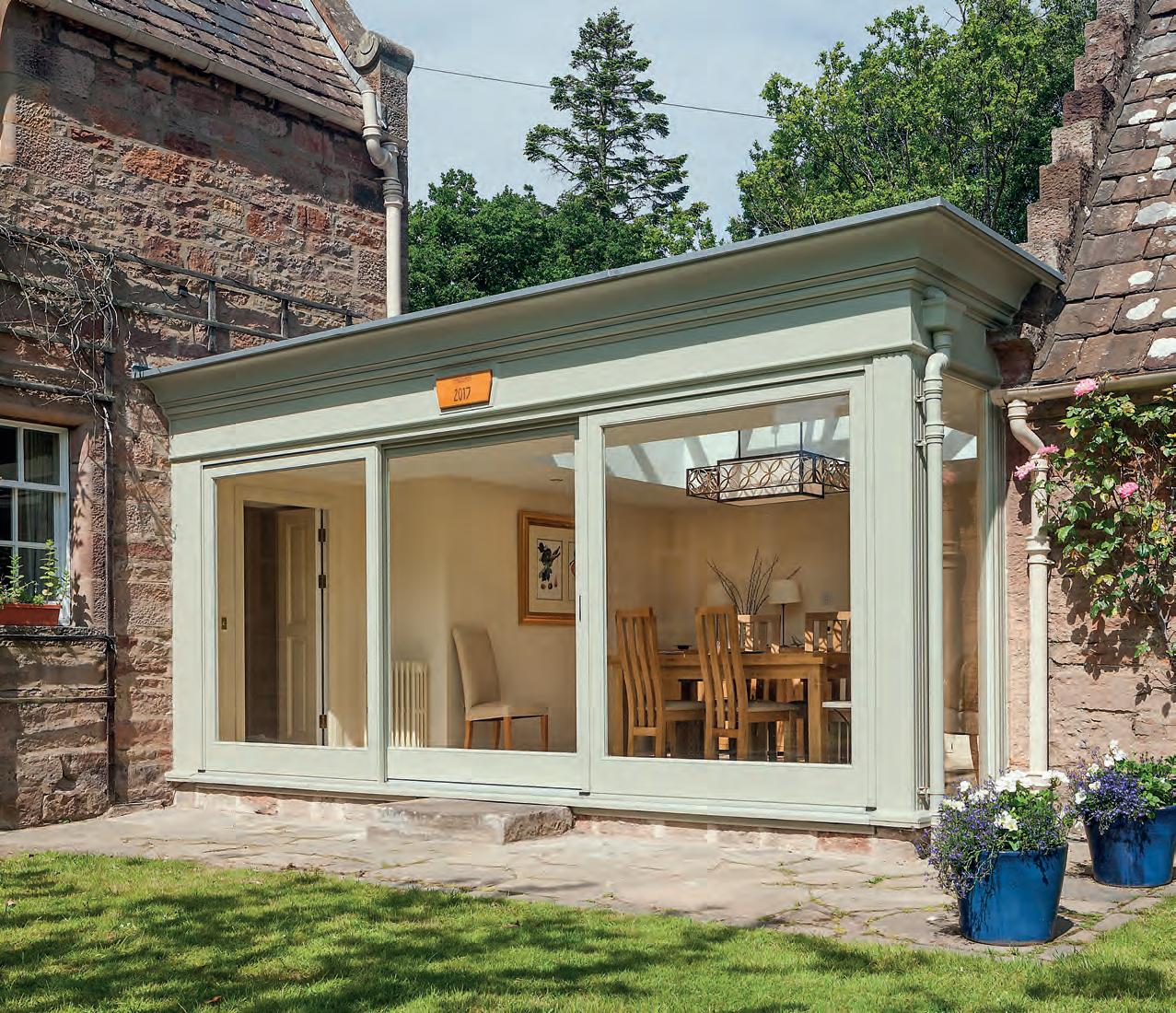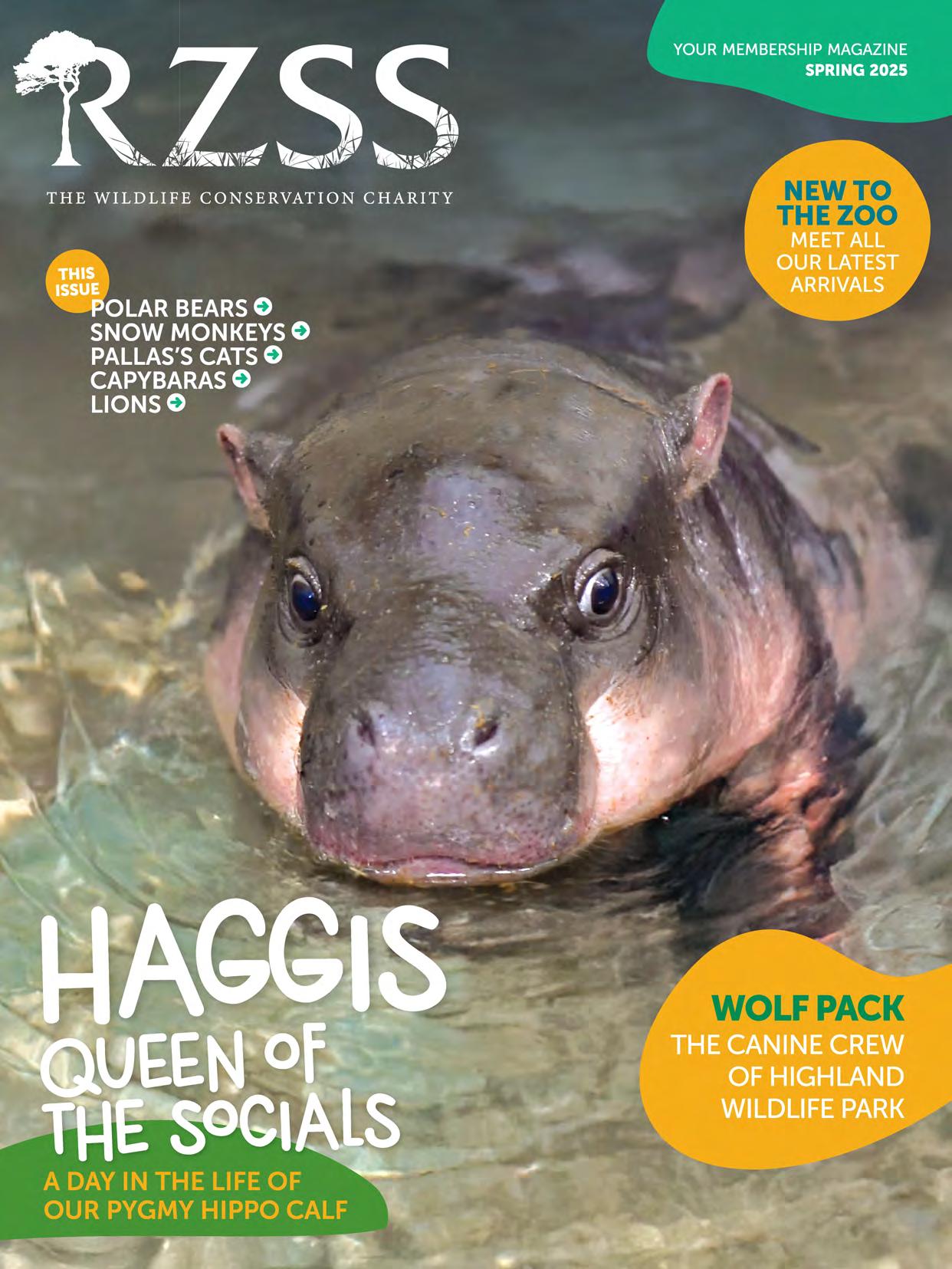

PER.fECT P0R___IUDGE IN EVERY WAY



PER.fECT P0R___IUDGE IN EVERY WAY
Your favourite Scottish porridge oats and oatmeal now available in recyclable paper bags
Brown, milled and packed in 8colland

This is the official publication for members of the Royal Zoological Society of Scotland (RZSS), the wildlife conservation charity (Scottish registered charity SC004064)
Your membership magazine and its envelope are made using paper from sustainably managed forests and are recyclable. For more information about RZSS,including details of our patrons, board and staff, visit rzss.org.uk
All content in this magazine is ©RZSS unless stated otherwise.
For any editorial enquiries, please write to Membership, RZSS, 134 Corstorphine Road, Edinburgh EH12 6TS
Or email us at membership@rzss.org.uk
www.carbonbalancedpaper.com
CBP016930
RZSSEditorial Team
Alan Bannon, Celia Brady, Laura Moore, Christine Moorhouse, Lisa Robshaw, Ben Supple, Hollie Watson
Editor Emily Radway
Contributing Editor Jonathan McIntosh
Art Director George Walker
Photographers Laurie Campbell and the RZSScommunications team
Managing Editor Andrew Littlefield
Production Director Justin Masters
Executive Director John Innes
Commercial Partnerships Manager
Alison Fraser d: 0141 946 8708 e: alison.fraser@thinkpublishing.co.uk
Published by TH I N K w: wwwthinkpublishing.co.uk
Photographer Laurie Campbell paid a visit to Edinburgh Zoo to photograph this issue's cover star, Haggis the pygmy hippo, and many more of our new arrivals.
What a lively start to the year we've had at the Royal Zoological Society of Scotland.
As anyone who has visited Edinburgh Zoo recently will have seen, lots of new animals have joined us in recent months and the whole team here have enjoyed getting to know them all.
Among the most recent to move in are two very lovable young capybaras, who have had a brand new enclosure expertly created for them by our teams. It's been 15 years since we last had capybaras in the zoo, and these charming young explorers are capturing many hearts.
Also winning many fans is our young celebrity of a pygmy hippo, Haggis. Now that the weather has warmed up, Haggis has started venturing outdoors, offering more of her adoring fans the opportunity to meet this small but mighty hippopotamus. I can recommend the Haggis Trivia Trail at Edinburgh Zoo as a great way of
Specialist gardening journalist Aileen Scoular worked with Edinburgh Zoo's head gardener Rab Harden to create our first gardening column. Check it out on page 48.
learning more about Haggis and the other animals at the zoo.
Coming soon, we'll also be launching Edinburgh Zoo's first app, which will allow our members and visitors to explore the zoo and its collections even more easily with the help of a mobile phone or tablet. Keep an eye on your member emails for news on when you can download it!
Up in the Highlands it's also been a very busy few months. Following the exciting opening of our new learning centres in 2024, this year we're unveiling our new shop and eatery at Highland Wildlife Park. As the weather warms up and the days lengthen, it's the ideal time of year to plan a visit to meet our polar bears, tigers, elks and moreand to learn more about Scotland's wildlife and what we can all do to
David Field, Chief Executive Officer
Contributing editor
Jonathan McIntosh had the opportunity to learn all about the newest youngsters and latest animals to move into Edinburgh Zoo.
Your membership
Visitthe animalsat EdinburghZoo and HighlandWildlife Parkas often as you like, plus...

Free parking at Edinburgh Zoo. Remember to get your ticket validated at the members gate or admissions on arrival.
Reduced price tickets for our brilliant events -turn to page 43 for details of what's coming up, and head to our website for tickets.
Treat up to six people to 25% off the cost of entry when they visit Edinburgh Zoo or Highland Wildlife Park with you.
Discounts in our cafes, restaurants and gift shops, including the new facilities at Highland Wildlife Park, opening this spring.
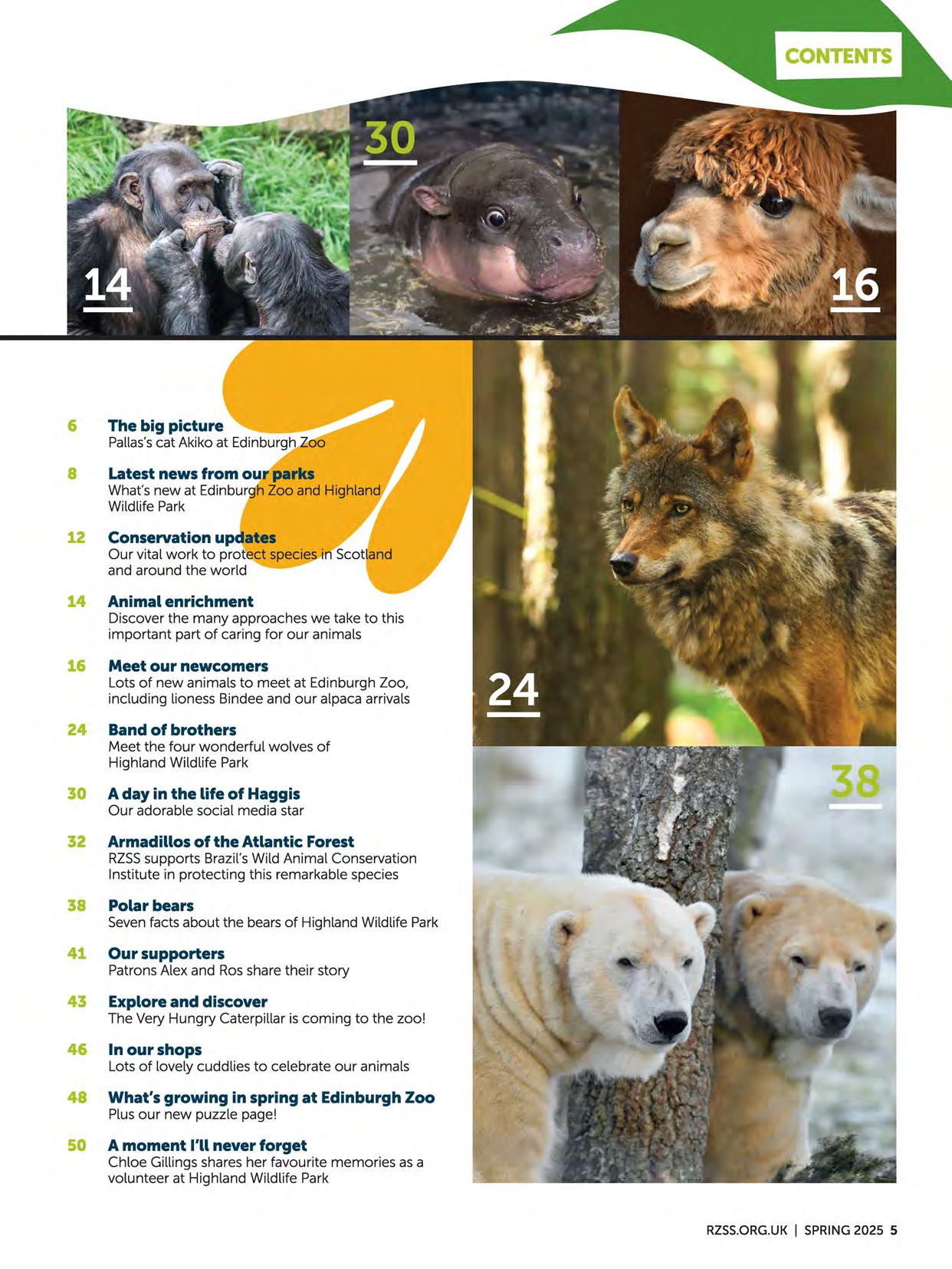
6 The big picture Pallas'scat Akiko at Edinburgh
8 Latest news from ou parks
What's new at Edinburg· Zoo and Highland Wildlife Park
12 Conservation up ates
Our vital work to prot ct species in Scotland and around the world
14 Animal enrichment
Discover the many approaches we take to this important part of caring for our animals
16 Meet our newcomers
Lots of new animals to meet at Edinburgh Zoo, including lioness Bindee and our alpaca arrivals
24 Band of brothers
Meet the four wonderful wolves of Highland Wildlife Park
30 A day in the life of Haggis Our adorable social media star
32 Armadillos of the Atlantic Forest RZSSsupports Brazil's Wild Animal Conservation Institute in protecting this remarkable species
38 Polar bears
Seven facts about the bears of Highland Wildlife Park
41 Our supporters Patrons Alex and Ros share their story
43 Explore and discover The Very Hungry Caterpillar is coming to the zoo!
46 In our shops
Lots of lovely cuddlies to celebrate our animals
48 What's growing in spring at Edinburgh Zoo
Plus our new puzzle page!
50 A moment I'll never forget
Chloe Gillings shares her favourite memories as a volunteer at Highland Wildlife Park
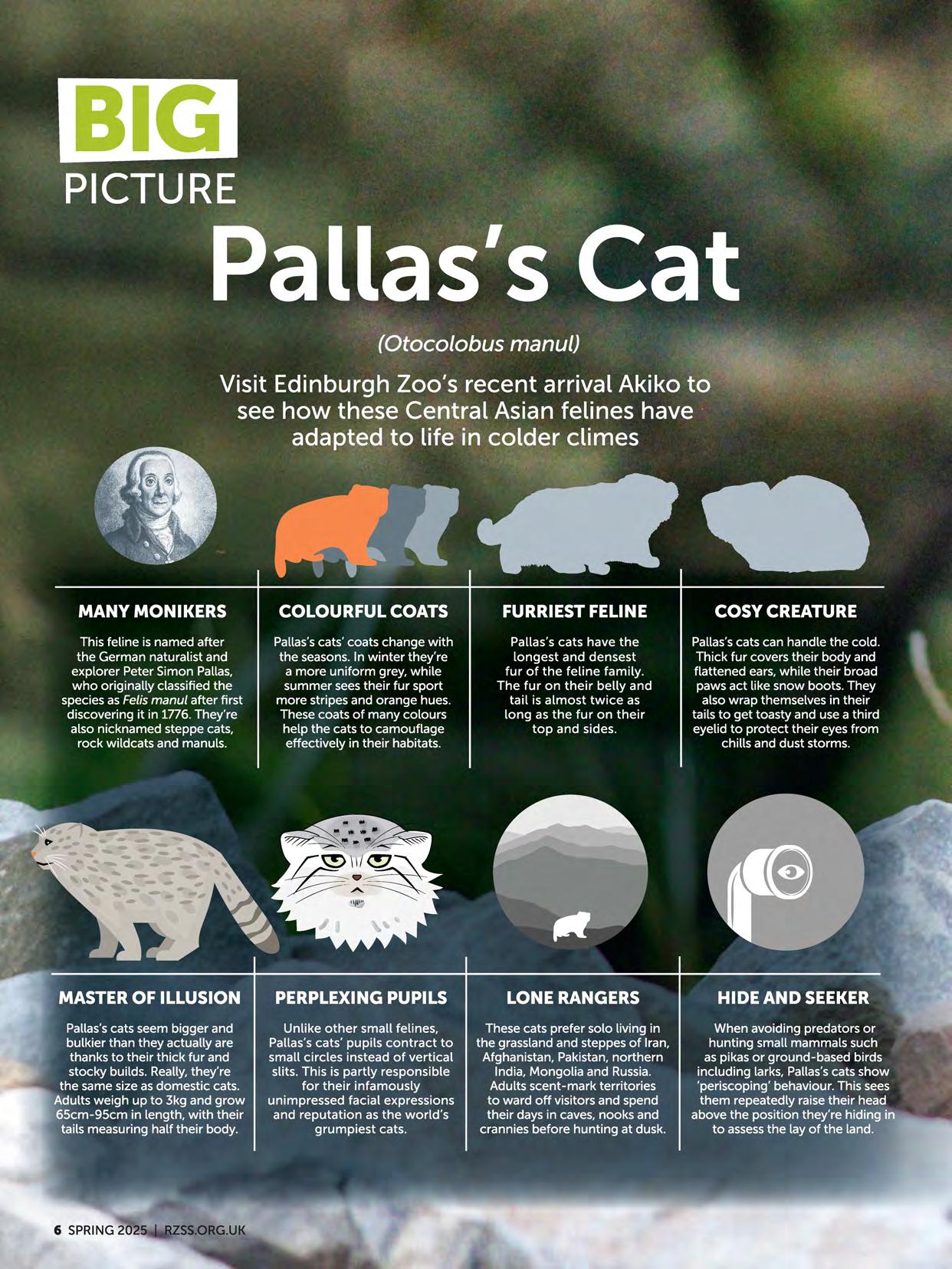
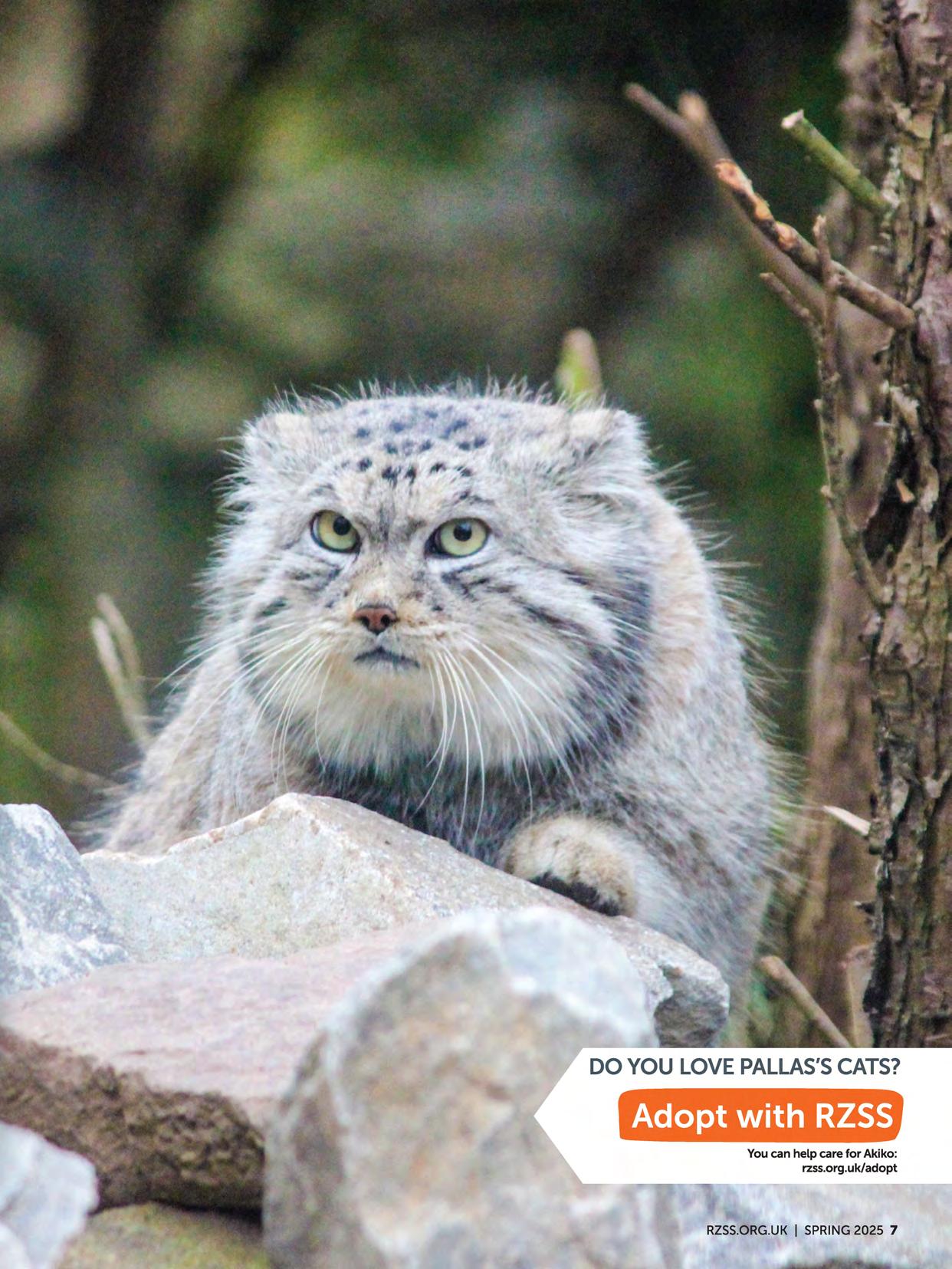
Our call for tighter restrictions on fireworks has received enormous support since the unexpected deaths of our three-month-old baby red panda. Roxie. last Bonfire Night. and her mum. Ginger. five days earlier.
To ensure these sad events never happen again, we're politely asking residents nearby Edinburgh Zoo to not set oft fireworks so that our animals aren't put under unnecessary stress.
From keeping them indoors and providing deep bedding, we do all we can to protect the zoo's animals from noise. Firework control zones could help safeguard them further.
·we·ve been inundated with messages from people shocked by what happened to Roxie and who believe the UK Government should ban fireworks from being sold to the public due to the severe impact they can have on animals: says RZSS'sdeputy chief executive, Ben Supple.
'Restricting firework displays to organised events would help avoid devastating consequences for animals while ensuring people can still enjoy traditional celebrations where they're used."
Three lynx illegally released in the Cairngorms are doing well, having completed their 30-day quarantine at Edinburgh Zoo.
The animals have temporarily been given the names 'A', 'B' and 'C', which is how animals were named by the charity's founder, Thomas Gillespie, when Edinburgh Zoo first opened in 1913.
Our experts humanely trapped the lynx in early January after they were spotted near Kingussie. It has now been confirmed that all three

are female and believedto be less than a year old. Sadly,a fourth lynx, who was male and a similarage, died overnightafter being captured in January.
RZSSchief executive David Fieldsays,"Illegallyreleasing these cats into the wild was highlyirresponsible.
'Thankfully,the lynxare healthyand recoveringin our quarantinefacilitiesat Edinburgh Zoo. Our team of expert keepers and veterinarianshave been delighted by how well they have settled in."
After such an amazing response in 2024, we are once again running our animal photography competition for RZSSmembers in 2025.
With over 100 fantastic entries last year and some truly outstanding winners, we loved seeing how inspired our members are by the animals at Edinburgh Zoo and Highland Wildlife Park -and we cannot wait to see more examples of your talents this year.
We will be selecting two overall winners: one in the adult category (aged 16 or over) and one in the junior category (aged 8 to 15) as well as a selection of runners-up. The winning photographs will then be printed in the 2026 RZSScalendar.
Our adult competition winner will get to be an Edinburgh Zoo keeper for a day, while the young winner will enjoy a junior keeper experience. All our winners and runners-up will also receive free renewal of their RZSSmembership and a copy of the 2026 RZSScalendar, featuring their photos.

Send your photographs to: rzss@thinkpublishing.co.uk along with your name, address and phone number, stating whether you are entering the adult or junior category. If you are entering the junior category, please include details of your age.
Please note that we will need photographs to be supplied at a high resolution to be suitable for publication, ideally around 4-5MB per
Closing date: 1 June 2025
Read full terms and conditions at rzss.org.uk/photographycompetition
There are even more reasons to visit Highland Wildlife Park this spring thanks to the opening of our great new shop and cafe, hot on the heels of the launch of Scotland's Wildlife Discovery Centre last year.
Visitors will find some exciting facilities across our three new centres, including an interactive exhibition and a hilltop den where you can learn
all about our conservation work while looking out over the wildcat breeding for release centre and the wider Cairngorms landscape. Just don't forget to spend time with all our amazing animals too!
The addition of our new shops and eateries offers more opportunities to indulge in a spot of retail therapy or to fuel up during your days out with us.
Looking for a unique venue to host your meetings, workshops or special events? Highland Wildlife Park's Leaming Hive could be the perfect fit. Featuring flexible spaces that can accommodate up to 70 guests, the Leaming Hive's eco-conscious design incorporates underfloor heating, a sedum roof and locally sourced materials.
Our team are dedicated to helping you create memorable events in a remarkable new space that supports our biodiversity and conservation efforts.
Visit highlandwildlifepark.org.uk/ venue-hire
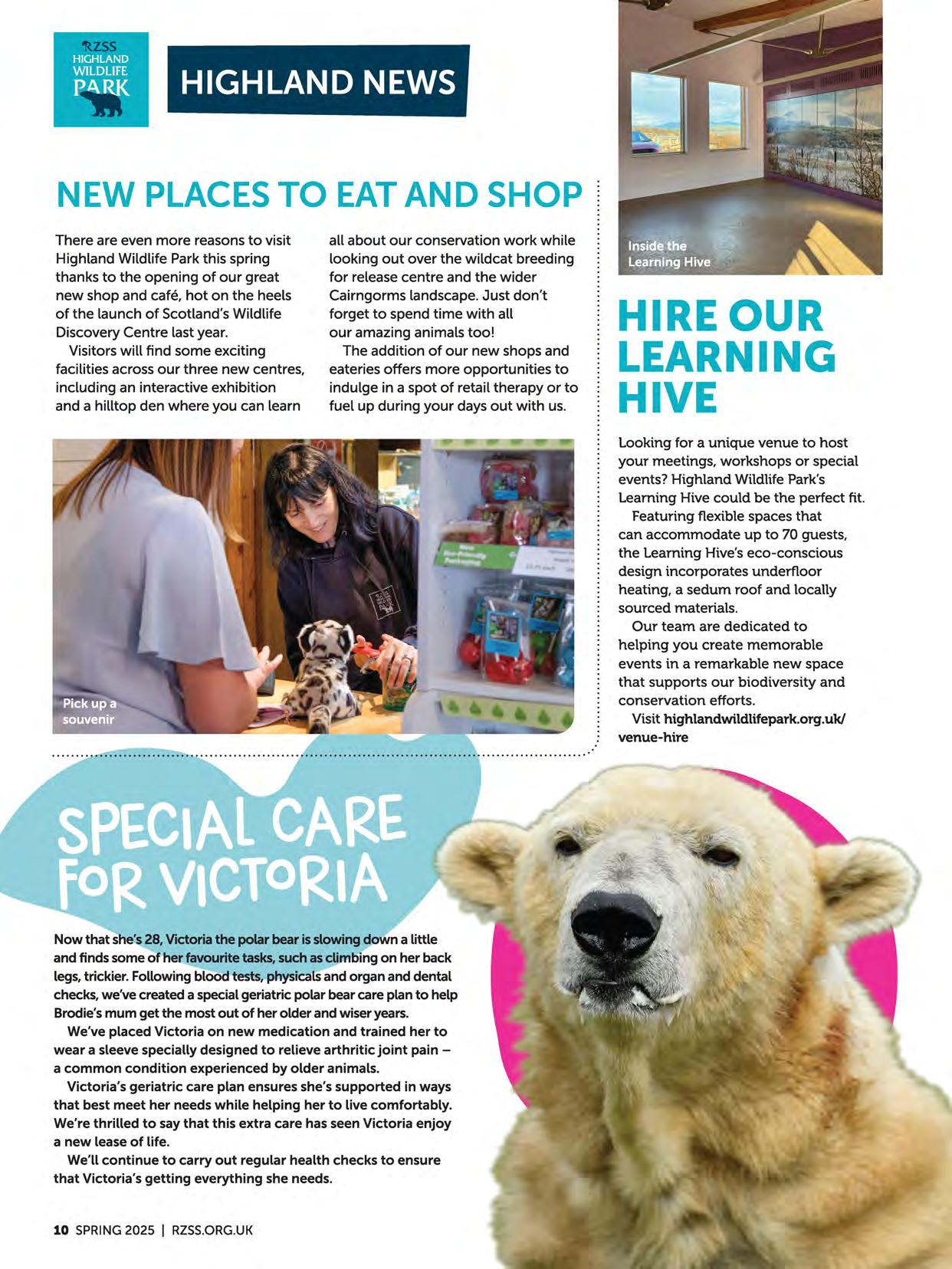
Now that she's 28, Victoria the polar bear is slowing down a little and finds some of he[ favourite tasks, such as climbing on her back legs, trickier. Following blood tests, physicalsand organ and dental checks, we've created a special geriatric polar bear care plan to help Brodie's mum get the most out of her older and wiser years.
We've placed Victoria on new medication and trained her to wear a sleeve specially designed to relieve arthritic joint paina common condition experienced by older animals.
Victoria's geriatric care plan ensures she's supported in ways that best meet her needs while helping her to live comfortably. We're thrilled to say that this extra care has seen Victoria enjoy a new lease of life.
We'll continue to carry out regular health checks to ensure that Victoria's getting everything she needs.
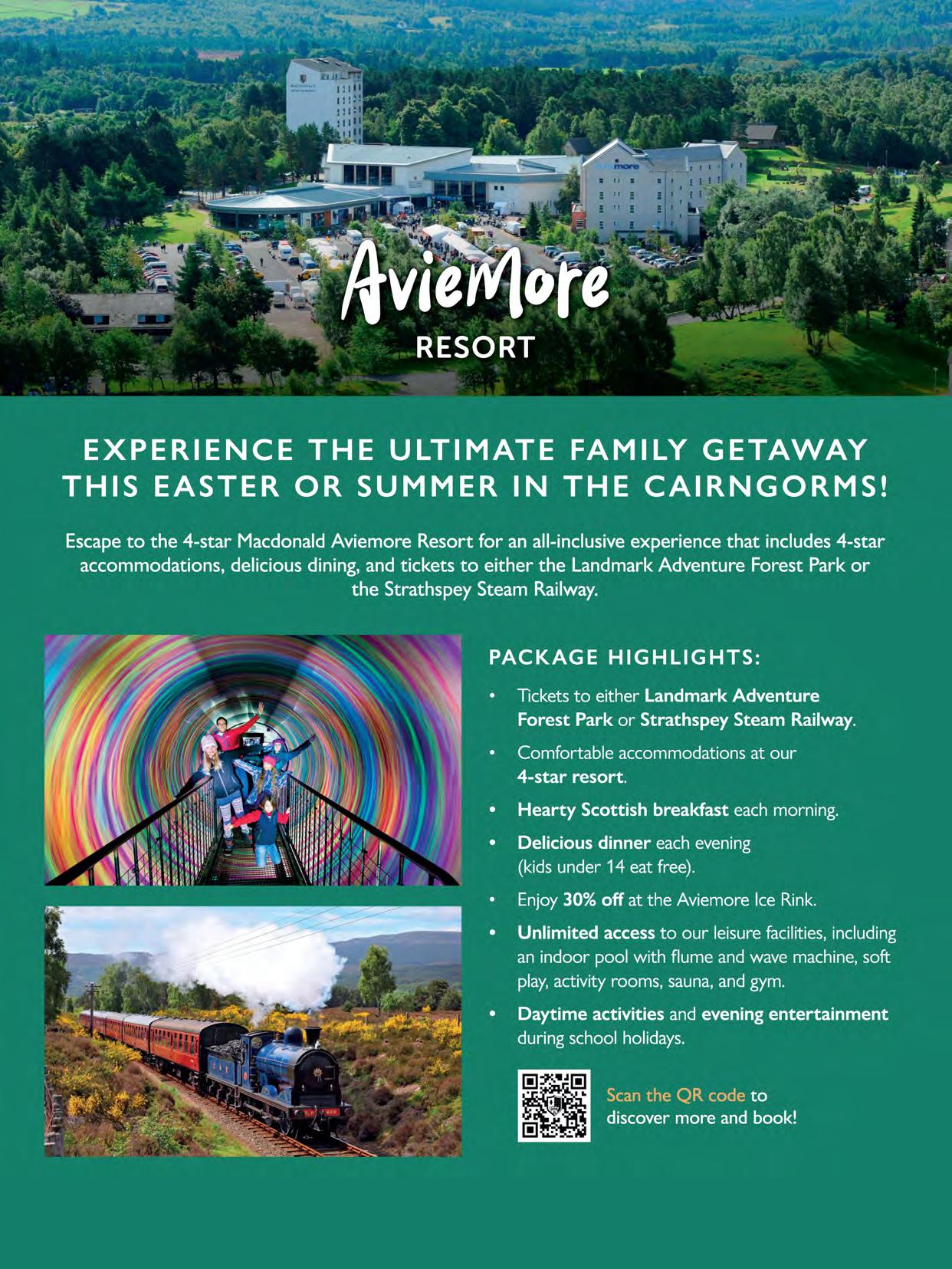
SCOTLAND
Our collaborative project aiming to restore Scotland's medicinal leech population welcomed the arrival of its first 20 babies at Highland Wildlife Park in November.
Britain's largest leeches were once prevalent in Scotland but populations have dwindled due to habitat loss, pollution and centuries of harvesting by humans for medical purposes. They are now only known to be found in three lochs in Scotland: in Argyll, Islay and Dumfries and Galloway.
RZSSscientists, keepers and vets are dedicating a huge amount of time and effort to caring for the leeches in the breeding programme, adapting our facilities to meet the animals' needs.
In partnership with Buglife, Species on the Edge and local communities, we'll hopefully soon start releasing the leeches at suitable locations to help secure a stronger future for the species.
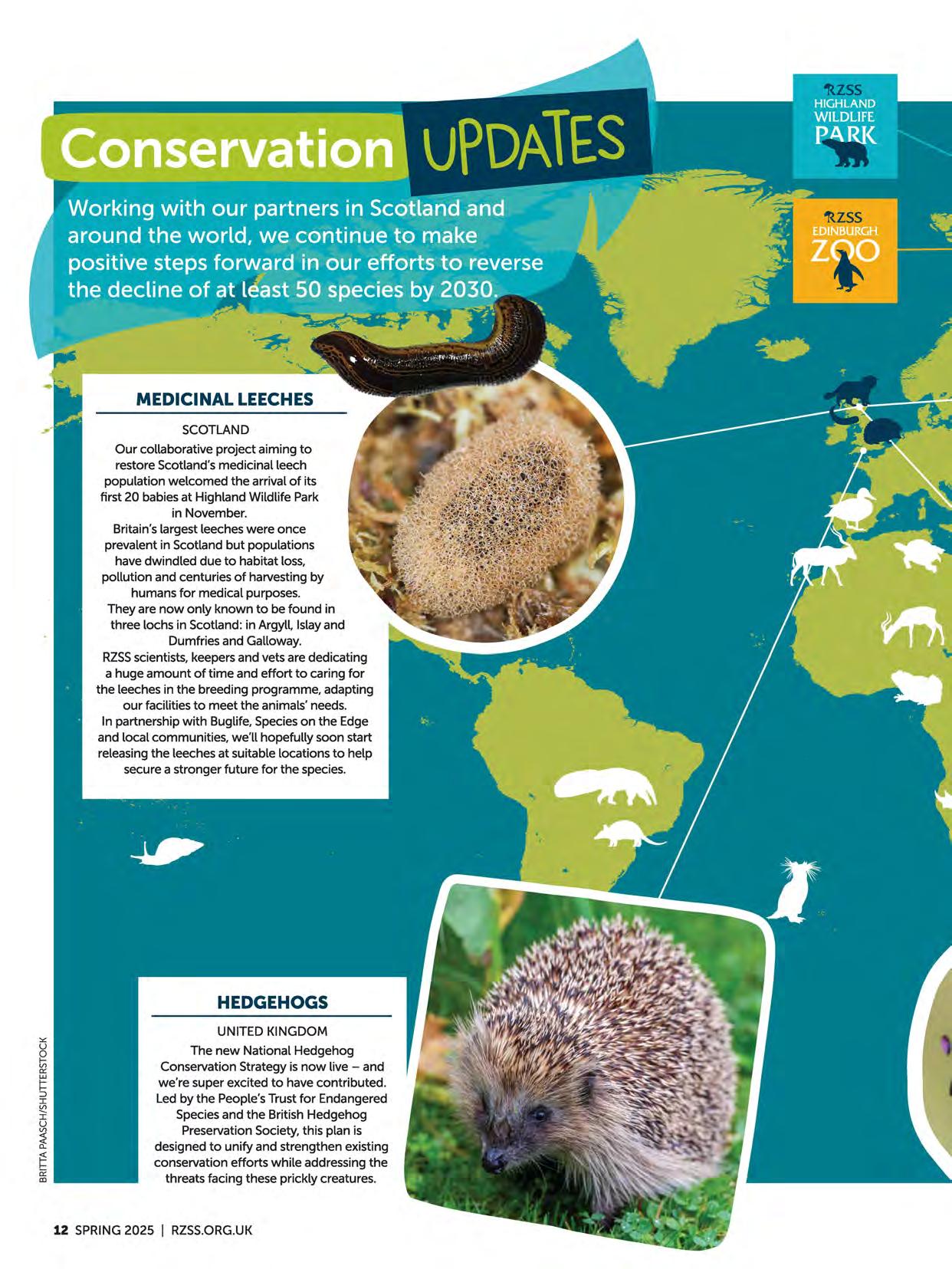
UNITED KINGDOM
The new National Hedgehog Conservation Strategy is now live -and we're super excited to have contributed. Led by the People's Trust for Endangered Species and the British Hedgehog Preservation Society, this plan is designed to unify and strengthen existing conservation efforts while addressing the threats facing these prickly creatures.
HIGHLAND WILDLIFE PARK
Wildcats: Cait ann an Cunnart, a new twopart documentary chronicling the progress of the Saving Wildcats conservation partnership, led by RZSS,was broadcast on BBC ALBA in January. It takes viewers behind the scenes of the Saving Wildcats team's incredible efforts to release captive bred wildcats from Highland Wildlife Park's specialised breeding for release centre in the Cairngorms National Park. From adjusting to rugged terrain and dealing with Scotland's unpredictable weather to wildcats learning to thrive on their own, the series covers the challenges and highs experienced during the first year of releases in 2023. It also shows Saving Wildcats' determined efforts to bring together scientific and conservation expertise to save these animals.
Watch the documentary at www.bbc.co.uk/iplayer/episodes/ m0026r4v/wildcats-cait-ann-an-cunnart
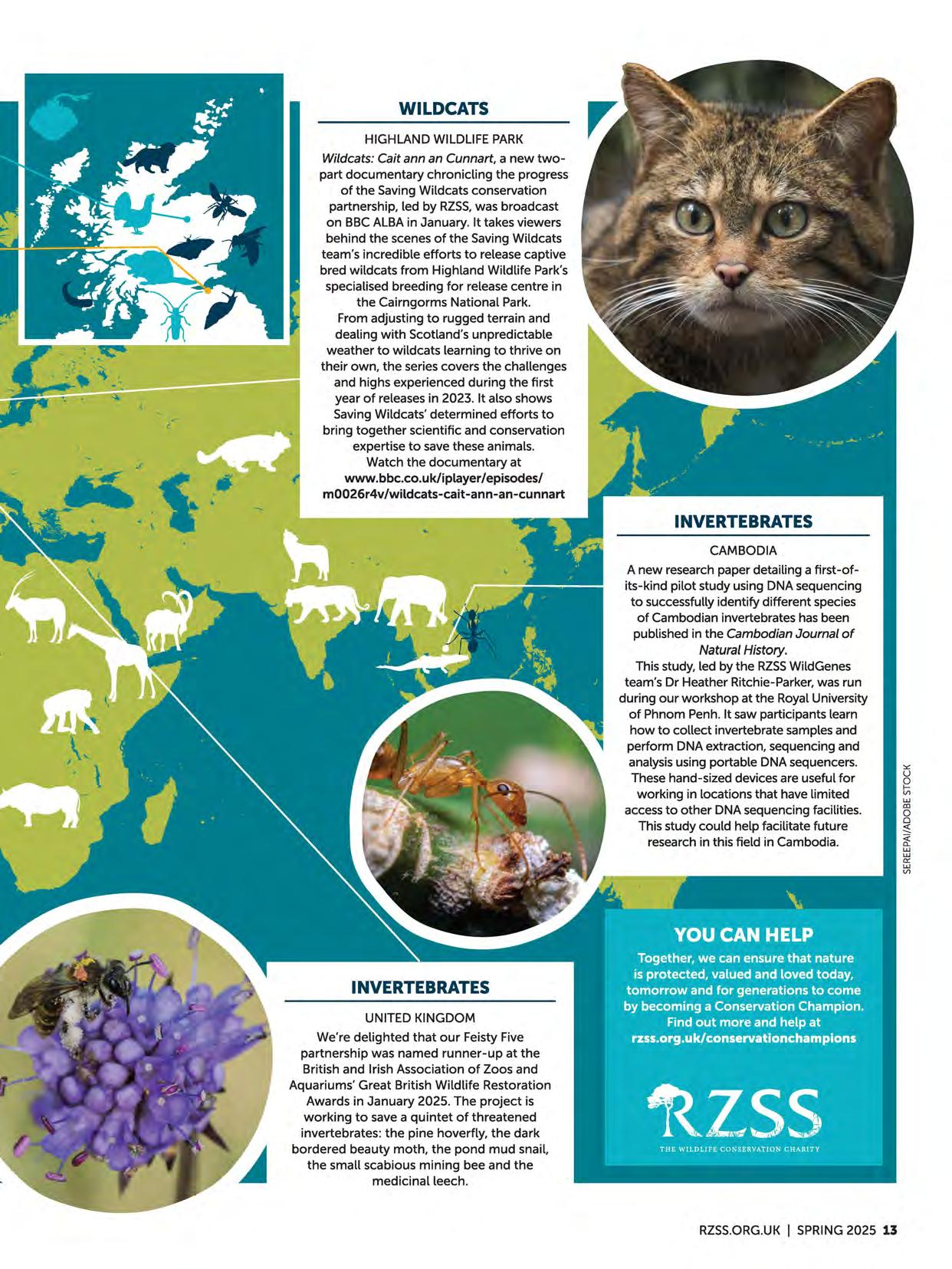
A new research paper detailing a first-ofits-kind pilot study using DNA sequencing to successfully identify different species of Cambodian invertebrates has been published in the Cambodian Journal of Natural History.
This study, led by the RZSSWildGenes team's Dr Heather Ritchie-Parker, was run during our workshop at the Royal University of Phnom Penh. It saw participants learn how to collect invertebrate samples and perform DNA extraction, sequencing and analysis using portable DNA sequencers. These hand-sized devices are useful for working in locations that have limited access to other DNA sequencing facilities. This study could help facilitate future research in this field in Cambodia.
We're delighted that our Feisty Five partnership was named runner-up at the British and Irish Association of Zoos and Aquariums' Great British Wildlife Restoration Awards in January 2025. The project is working to save a quintet of threatened invertebrates: the pine hoverfly, the dark bordered beauty moth, the pond mud snail, the small scabious mining bee and the medicinal leech.
Anything we add to our animals' usual environments to give them new and stimulating sights, smells, tastes, activities and challenges.
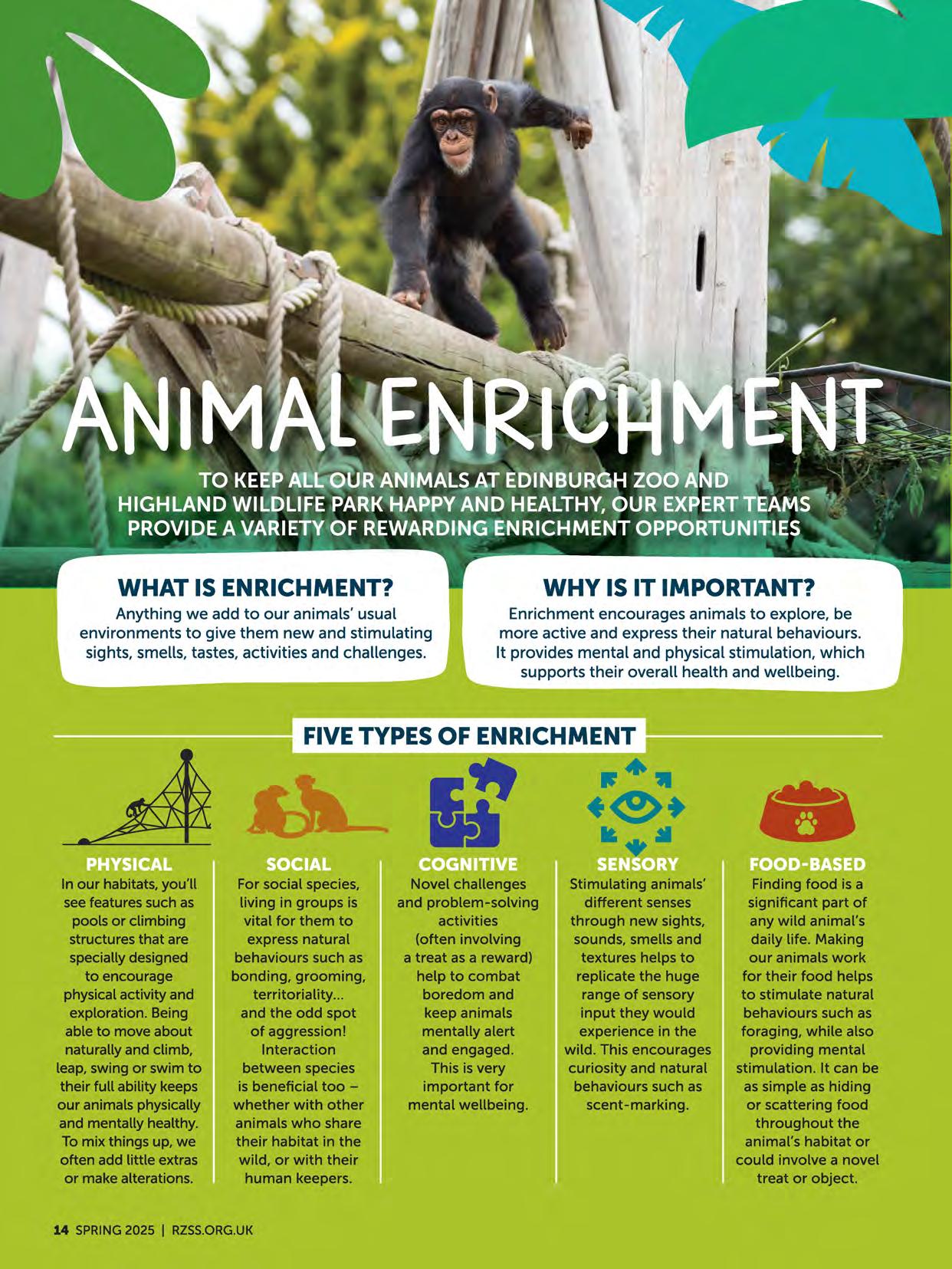
Enrichment encourages animals to explore, be more active and express their natural behaviours. It provides mental and physical stimulation, which supports their overall health and wellbeing.
In our habitats, you'll For social species, Novel challenges
Stimulating animals' Finding food is a see features such as living in groups is and problem-solving different senses significant part of pools or climbing vital for them to activities through new sights, any wild animal's structures that are express natural (often involving sounds, smells and daily life. Making specially designed behaviours such as a treat as a reward) textures helps to our animals work to encourage bonding, grooming, help to combat replicate the huge for their food helps physical activity and territoriality ... boredom and range of sensory to stimulate natural exploration. Being and the odd spot keep animals input they would behaviours such as able to move about of aggression! mentally alert experience in the foraging, while also naturally and climb, Interaction and engaged. wild. This encourages providing mental leap, swing or swim to between species This is very curiosity and natural stimulation. It can be their full ability keeps is beneficial too -important for behaviours such as as simple as hiding our animals physically whether with other mental wellbeing. scent-marking. or scattering food and mentally healthy. animals who share throughout the To mix things up, we their habitat in the animal's habitat or often add little extras wild, or with their could involve a novel or make alterations. human keepers. treat or object.
Hiding treats in packaging such as cardboard boxes, paper bags or hessian sacks is a simple and versatile form of enrichment for a wide range of species, from meerkats to big cats. It stimulates curiosity, encourages natural foraging and feeding behaviours and requires animals to use their physical strength. For special occasions such as birthdays, keepers have fun creating particularly enriching gifts.
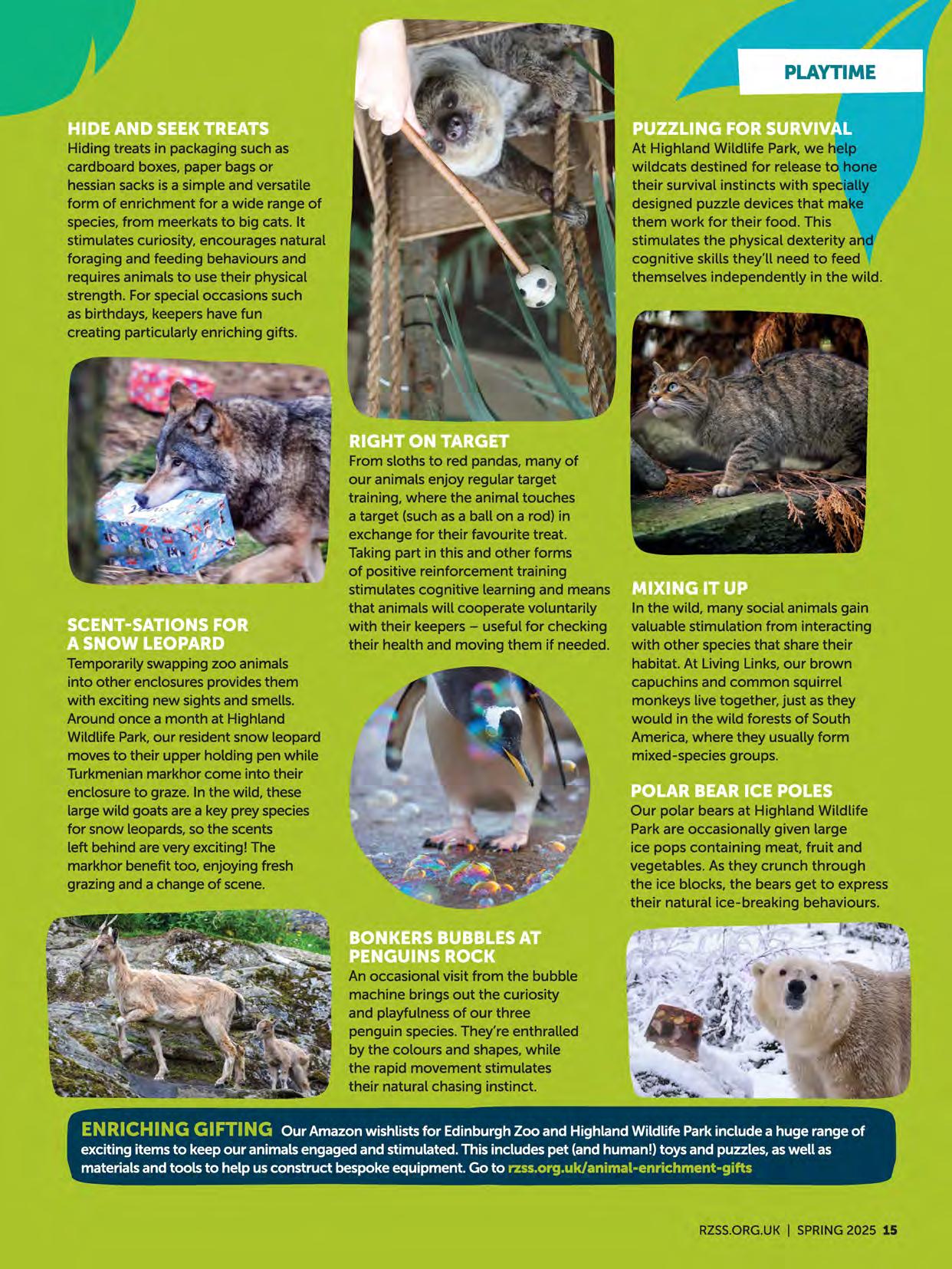
Temporarily swapping zoo animals into other enclosures provides them with exciting new sights and smells. Around once a month at Highland Wildlife Park, our resident snow leopard moves to their upper holding pen while Turkmenian markhor come into their enclosure to graze. In the wild, these large wild goats are a key prey species for snow leopards, so the scents left behind are very exciting! The markhor benefit too, enjoying fresh grazing and a change of scene.
From sloths to red pandas, many of our animals enjoy regular target training, where the animal touches a target (such as a ball on a rod) in exchange for their favourite treat. Taking part in this and other forms of positive reinforcement training stimulates cognitive learning and means that animals will cooperate voluntarily with their keepers -useful for checking their health and moving them if needed.
At Highland Wildlife Park, we help wildcats destined for release to hone their survival instincts with specially designed puzzle devices that make them work for their food. This stimulates the physical dexterity and cognitive skills they'll need to feed themselves independently in the wild.
An occasional visit from the bubble machine brings out the curiosity and playfulness of our three penguin species. They're enthralled by the colours and shapes, while the rapid movement stimulates their natural chasing instinct.
In the wild, many social animals gain valuable stimulation from interacting with other species that share their habitat. At Living Links, our brown capuchins and common squirrel monkeys live together, just as they would in the wild forests of South America, where they usually form mixed-species groups.
Our polar bears at Highland Wildlife Park are occasionally given large ice pops containing meat, fruit and vegetables. As they crunch through the ice blocks, the bears get to express their natural ice-breaking behaviours.
ENRICHING GIFTING
Our Amazon wishlists for Edinburgh Zoo and Highland Wildlife Park include a huge range of exciting items to keep our animals engaged and stimulated. This includes pet (and human!) toys and puzzles, as well as materials and tools to help us construct bespoke equipment. Go to rzss.org.uk/animal-enrichment-gifts

EDINBURGH ZOO'S DONALD GOW INTRODUCES SOME OF THE LATEST ARRIVALS YOU CAN LOOK FORWARD TO MEETING ON YOUR NEXT VISIT INTERVIEW: JONATHAN MCINTOSH
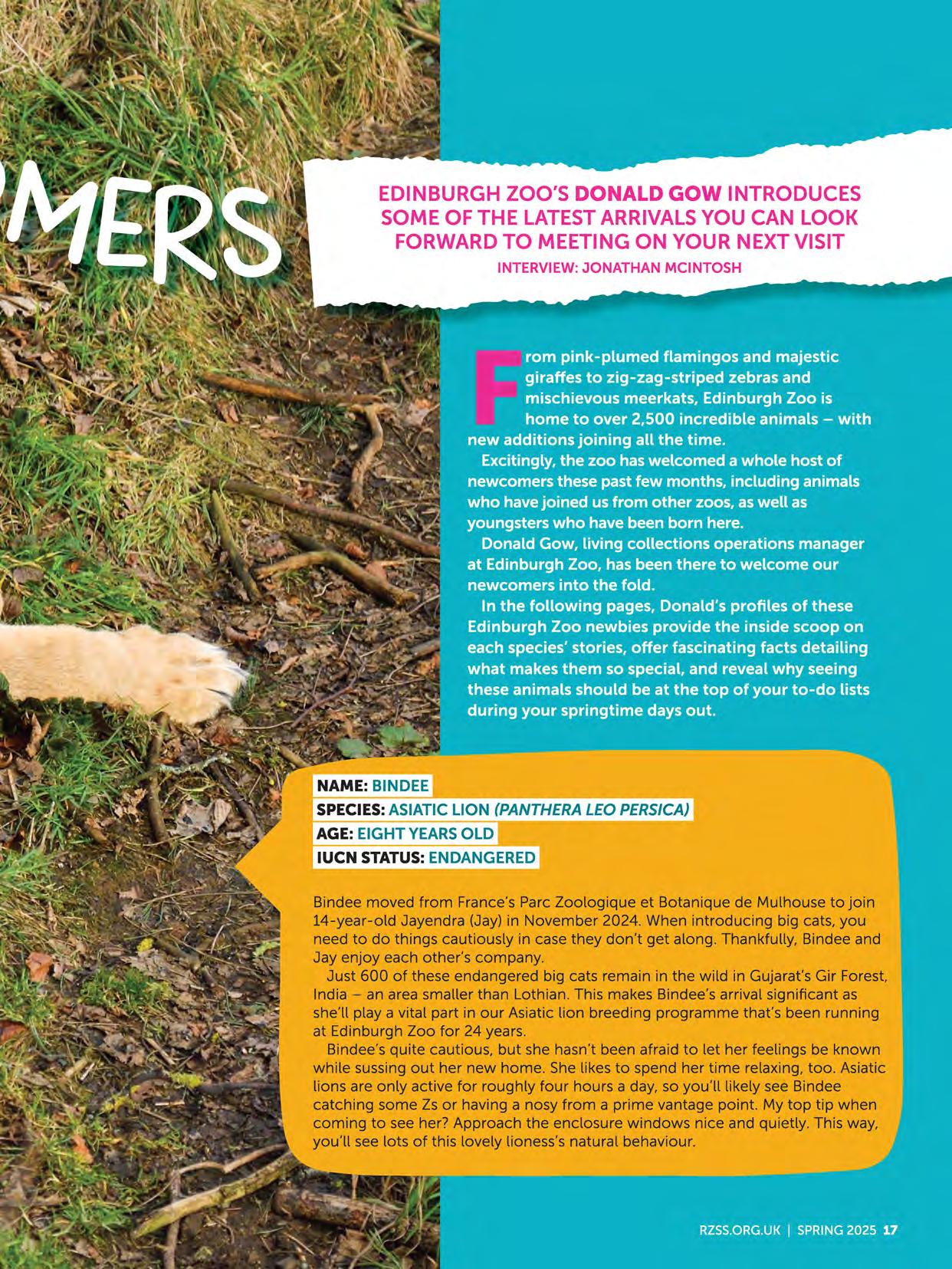
NAME: BINDEEI
SPECIES:ASIATIC LION (PANTHERALEO PERS/CA)I
AGE: EIGHT YEARSOLD I
IUCN STATUS:ENDANGEREDI
Sindee moved from France's Pare Zoologique et Sotanique de Mulhouse to join 14-year-old Jayendra (Jay) in November 2024. When introducing big cats, you need to do things cautiously in case they don't get along. Thankfully, Sindee and Jay enjoy each other's company.
Just 600 of these endangered big cats remain in the wild in Gujarat's Gir Forest India -an area smaller than Lothian. This makes Sindee's arrival significant as she'll play a vital part in our Asiatic lion breeding programme that's been running at Edinburgh Zoo for 24 years.
Sindee's quite cautious, but she hasn't been afraid to let her feelings be known while sussing out her new home. She likes to spend her time relaxing, too. Asiatic lions are only active for roughly four hours a day, so you'll likely see Sindee catching some Zs or having a nosy from a prime vantage point. My top tip when coming to see her? Approach the enclosure windows nice and quietly. This way, you'll see lots of this lovely lioness's natural behaviour.

PALLAS'SCAT
OTOCOLOBUS MANUL)
FOUR YEARSOLD ===:::::.... __ _
IUCN STATUS:LEASTCONCERN
At roughly the same size as a domestic tabby, this small cat has a hugely charismatic personality. He's not nearly as grumpy as his demeanour suggests, but Akiko gives us some serious side-eye when he's not happy with something!
Also known as manuls, Pallas·s cats live secretive lives in the steppes and grasslands of Central Asian countries such as Kyrgyzstan. Kazakhstan and Mongolia. The inaccessibility of these habitats means they're one of the world's most understudied wild cats.
Akiko is happiest and most confident when exploring the caves or peering over his domain from the high-up platforms peppered throughout the enclosure. This thick-furred feline is stealthy, so spotting him requires a keen eye. I'd recommend visiting again and again if you don't spot him on your first go -or if you just fancy another look at how handsome he is!
Edinburgh Zoo hasn't held Pallas·s cats for over a decade. so it's brilliant having Akiko with us. We'll be introducing him to a female soon. They'll help us promote the work of the Pallas·s Cat International Conservation Alliance (PICA), which RZSSformed with Sweden's Nordens Ark Zoo and the Snow Leopard Trust in 2016.
AGE: ONE AND TWO YEARSOLD
IUCN STATUS:LEASTCONCERN
We welcomed our two female Prevost's squirrels, Cantik and Raya, to the Magic Forest last summer. This is the first time this Southeast Asian species has set up home here -and we can't wait for you to meet them!
Prevost's squirrels are arboreal, meaning they prefer living in trees. Thankfully, their coat of many colours makes them a little easier to see.
Alternatively known as Asian tri-coloured or ornamental squirrels, their markings are amazing to behold, with black-brown fur on their head, back and tail, and fiery red fur on their underparts separated by streaks of white.
Cantik and Raya are very active. When visiting them, look at how they use their sharp claws and bushy tails to climb, jump between and balance on trees. They're even known to enjoy a bit of sunbathing on branches, so keep this in mind when the weather's good. The duo also enjoy scouring the forest floor in search of their favourite snacks. including seeds, nuts, fruits and insects.
We're hoping to introduce male Prevost's squirrels to the Magic Forest soon. so watch this space!
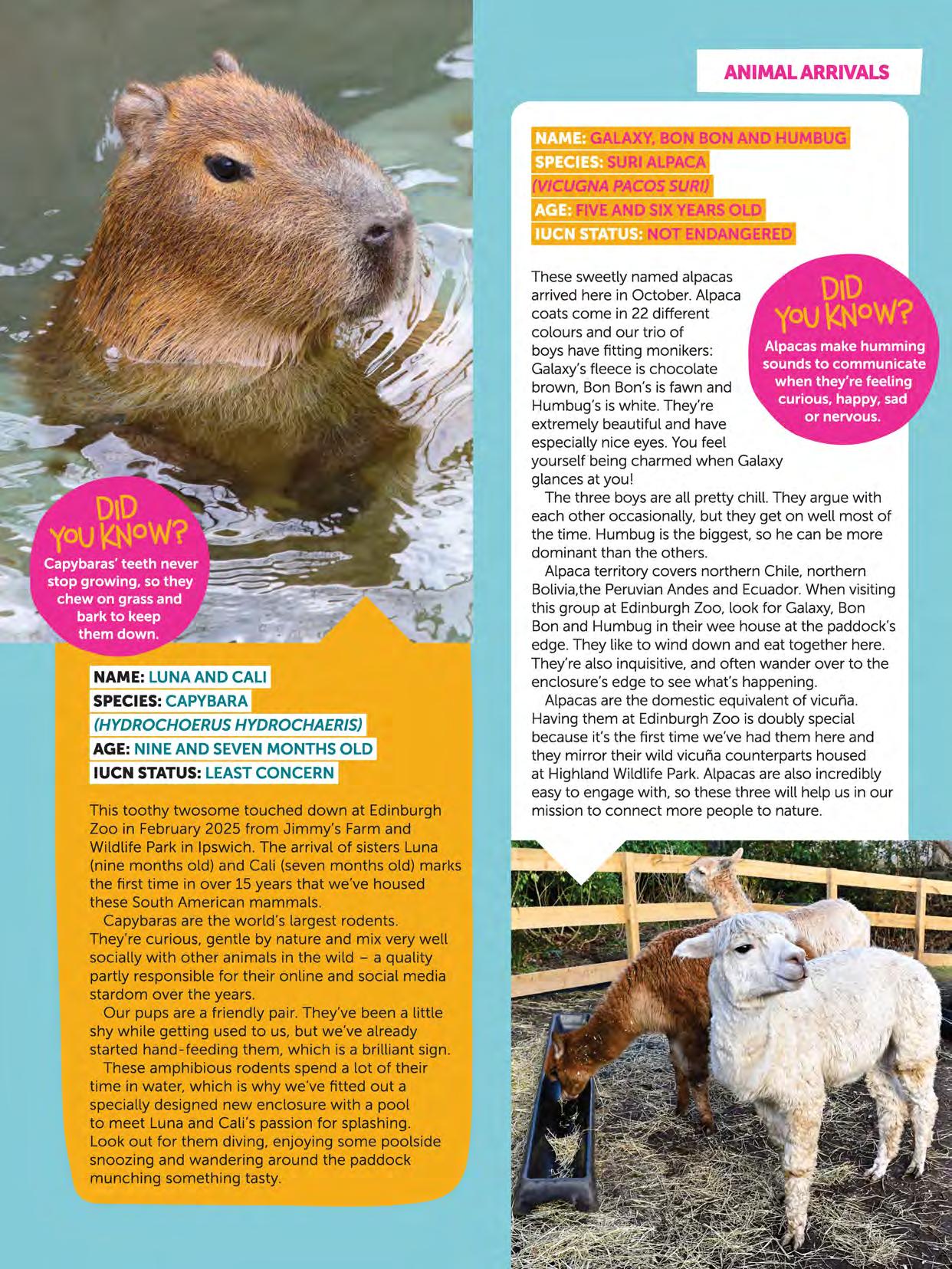
NAME: LUNA AND CALI I
SPECIES: CAPYBARA I
(HYDROCHOERUS HYDROCHAERIS) I
AGE: NINE AND SEVEN MONTHS OLD I
IUCN STATUS: LEAST CONCERN I
This toothy twosome touched down at Edinburgh Zoo in February 2025 from Jimmy's Farm and Wildlife Park in Ipswich. The arrival of sisters Luna (nine months old) and Cali (seven months old) marks the first time in over 15 years that we've housed these South American mammals.
Capybaras are the world's largest rodents. They're curious, gentle by nature and mix very well socially with other animals in the wild -a quality partly responsible for their online and social media stardom over the years.
Our pups are a friendly pair. They've been a little shy while getting used to us, but we've already started hand-feeding them, which is a brilliant sign.
These amphibious rodents spend a lot of their time in water, which is why we've fitted out a specially designed new enclosure with a pool to meet Luna and Cali's passion for splashing. Look out for them diving, enjoying some poolside snoozing and wandering around the paddock munching something tasty.
GALAX~BONBONANDHUMBUG
SURI ALPACA
FIVE AND SIX YEARS OLD
IUCN STATUS: NOT ENDANGERED
These sweetly named alpacas arrived here in October. Alpaca coats come in 22 different colours and our trio of boys have fitting monikers: Galaxy's fleece is chocolate brown, Bon Ban's is fawn and Humbug's is white. They're extremely beautiful and have especially nice eyes. You feel yourself being charmed when Galaxy glances at you!
The three boys are all pretty chill. They argue with each other occasionally, but they get on well most of the time. Humbug is the biggest, so he can be more dominant than the others.
Alpaca territory covers northern Chile, northern Bolivia.the Peruvian Andes and Ecuador. When visiting this group at Edinburgh Zoo, look for Galaxy, Bon Bon and Humbug in their wee house at the paddock's edge. They like to wind down and eat together here. They're also inquisitive, and often wander over to the enclosure's edge to see what's happening.
Alpacas are the domestic equivalent of vicufia. Having them at Edinburgh Zoo is doubly special because it's the first time we've had them here and they mirror their wild vicufia counterparts housed at Highland Wildlife Park. Alpacas are also incredibly easy to engage with, so these three will help us in our mission to connect more people to nature.

SPECIES: LOWLAND NYALA (TRAGELAPHUSANGASII)
AGE: FOUR MONTHS OLD
IUCN STATUS: LEAST CONCERN
Dahlia and Olena are Edinburgh Zoo's latest double act. Amazingly, they were both born on Saturday 19 October. But they're not twins, they just share the same dad: Arnold. Yara is Olena's mum and Poppy is Dahlia's.
It's amazingly rare that these young calves entered the world on the same day but seeing them grow up together is special. Extremely close, they're always together and they like to keep the adults -Poppy, Arnold, Arya, Yara and Eugene -on their toes. They're gorgeous to look at and incredibly graceful.
Lowland nyala are indigenous to the dense woodland of Southeast Africa and live in herds of up to 30 members. Currently, Dahlia and Olena are still staying close to the group's females.
Nyalas are at their most active in the mornings and late afternoons -prime times to see Dahlia and Olena. Watch out for the differences between adult males and females when you visit. Females are browner with more stripes and bigger ears, while males are darker, with a streak of fur along their backs, and impressive horns.
IUCN STATUS: ENDANGERED
Native to the Philippines, Visayan spotted deer are the world's rarest species of deer. It's estimated that only 700 of them now live wild on the islands of Panay and Negros.
Edinburgh Zoo's trio of Visayan spotted deer became a quartet in September 2024 when Tala made her way into the world. Born to mum and dad Lyra and Pablo, Tala is thriving.
While Visayan spotted deer are shy by nature, Tala seems to be the exception to that rule as she's quite bold. Given that she's still a baby, the little fawn likes being by her mum. But as time's gone on, this bright young thing is becoming more curious about the world around her. She's alert to everything!
Visayan spotted deer can be a little skittish, so it takes a bit of patience when trying to spot Tala, Lyra, Pablo and Watson. Make sure to take full advantage of the two paths from which you can view their Whitson Wood enclosure, each offering a unique perspective on the deer.
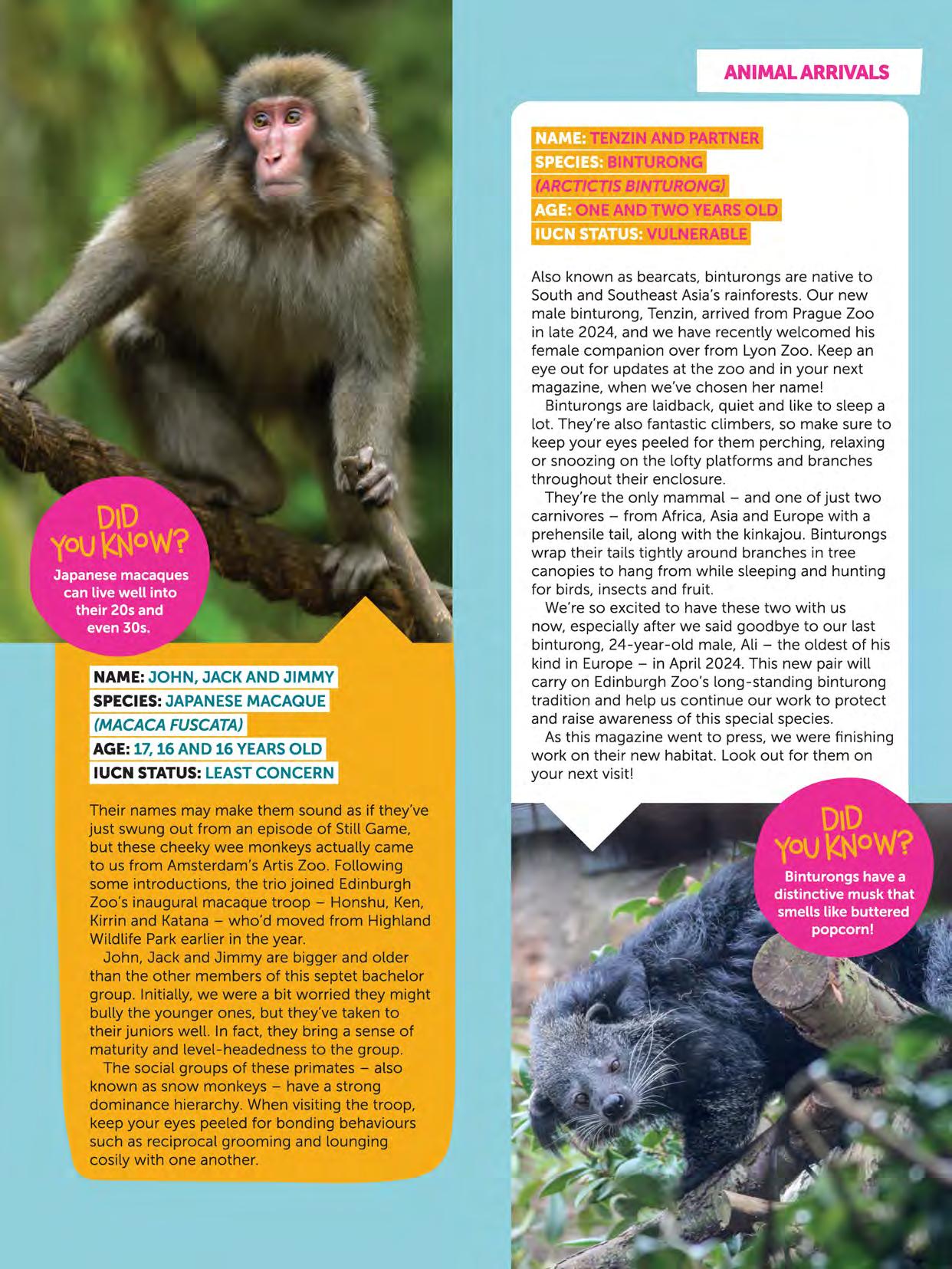
NAME: JOHN, JACK AND JIMMY I
SPECIES: JAPANESE MACAQUE I (MACACAFUSCATA)I
AGE: 17, 16 AND 16 YEARS OLD I
IUCN STATUS: LEAST CONCERN I
Their names may make them sound as if they've just swung out from an episode of Still Game, but these cheeky wee monkeys actually came to us from Amsterdam's Artis Zoo. Following some introductions, the trio joined Edinburgh Zoo's inaugural macaque troop -Honshu, Ken, Kirrin and Katana -who'd moved from Highland Wildlife Park earlier in the year.
John, Jack and Jimmy are bigger and older than the other members of this septet bachelor group. Initially, we were a bit worried they might bully the younger ones, but they've taken to their juniors well. In fact, they bring a sense of maturity and level-headedness to the group.
The social groups of these primates -also known as snow monkeys -have a strong dominance hierarchy. When visiting the troop, keep your eyes peeled for bonding behaviours such as reciprocal grooming and lounging cosily with one another.
ONE AND TWO YEARS OLD
IUCN STATUS: VULNERABLE
Also known as bearcats, binturongs are native to South and Southeast Asia's rainforests. Our new male binturong, Tenzin, arrived from Prague Zoo in late 2024, and we have recently welcomed his female companion over from Lyon Zoo. Keep an eye out for updates at the zoo and in your next magazine, when we've chosen her name!
Binturongs are laid back, quiet and like to sleep a lot. They're also fantastic climbers, so make sure to keep your eyes peeled for them perching, relaxing or snoozing on the lofty platforms and branches throughout their enclosure.
They're the only mammal -and one of just two carnivores -from Africa, Asia and Europe with a prehensile tail, along with the kinkajou. Binturongs wrap their tails tightly around branches in tree canopies to hang from while sleeping and hunting for birds, insects and fruit.
We're so excited to have these two with us now, especially after we said goodbye to our last binturong, 24-year-old male, Ali -the oldest of his kind in Europe -in April 2024. This new pair will carry on Edinburgh Zoo's long-standing binturong tradition and help us continue our work to protect and raise awareness of this special species.
As this magazine went to press, we were finishing work on their new habitat. Look out for them on your next visit!
Haggis the pygmy hippo has taken the world by storm since her arrival in October. She's a superstar! However, she's still a baby right now so she's sticking close to her mum, Gloria, while dad, Otto, lives separately until Haggis is bigger.
Pygmy hippos are native to the West African forests and swamps of Liberia, Sierra Leone and Guinea. These hard-to-reach habitats have prevented in-depth study of these secretive and solitary creatures, so being able to see

them up close at Edinburgh Zoo is incredible.
Habitat loss has reduced the wild pygmy hippo population to just 2,500. Up until recently, people were perhaps more familiar with their cousins, the common hippo. Thanks to Haggis's popularity, there's been a welcome boost in awareness of this rarer, nocturnal pygmy species, the challenges facing them and how RZSSis helping.
It's easy to see why everybody is head over heels with this Scottish sweetheart. Fittingly, she looks exactly like her namesake and is super cute, feisty and full of personality.
As the weather gets warmer, you'll see Haggis running about the enclosure and playing in the pool with her mum more and more -her favourite things to do.
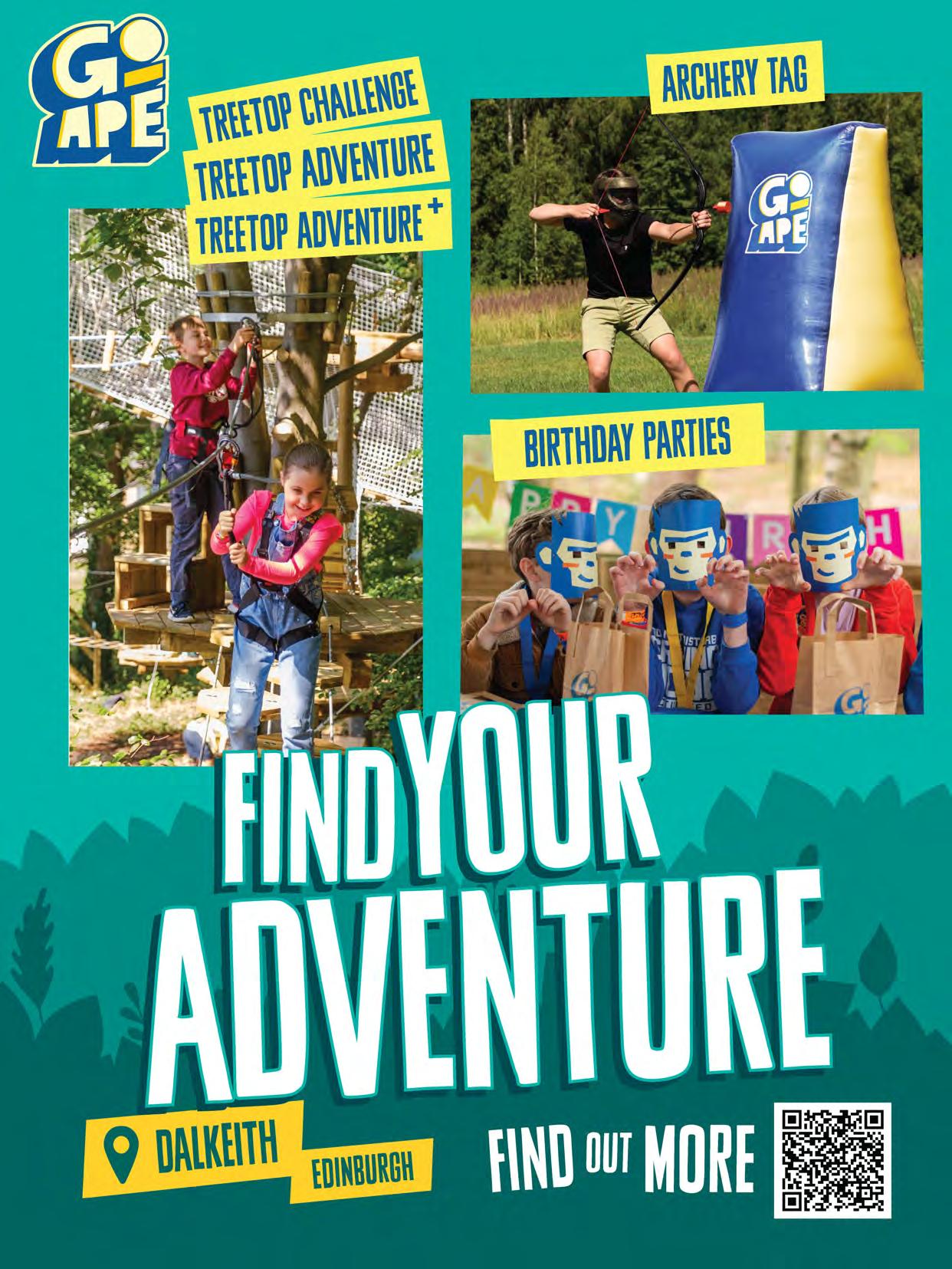
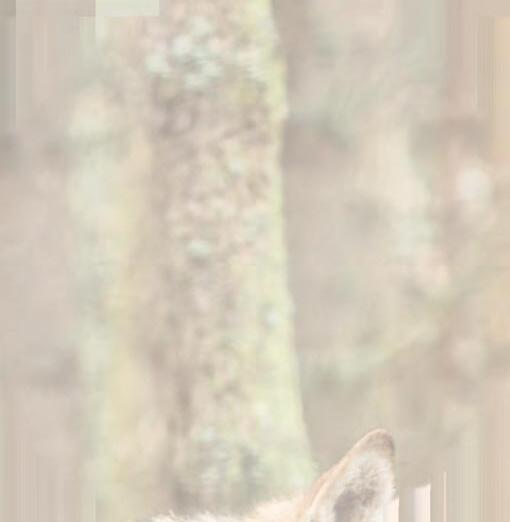
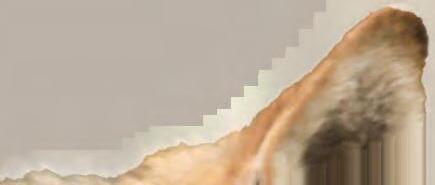
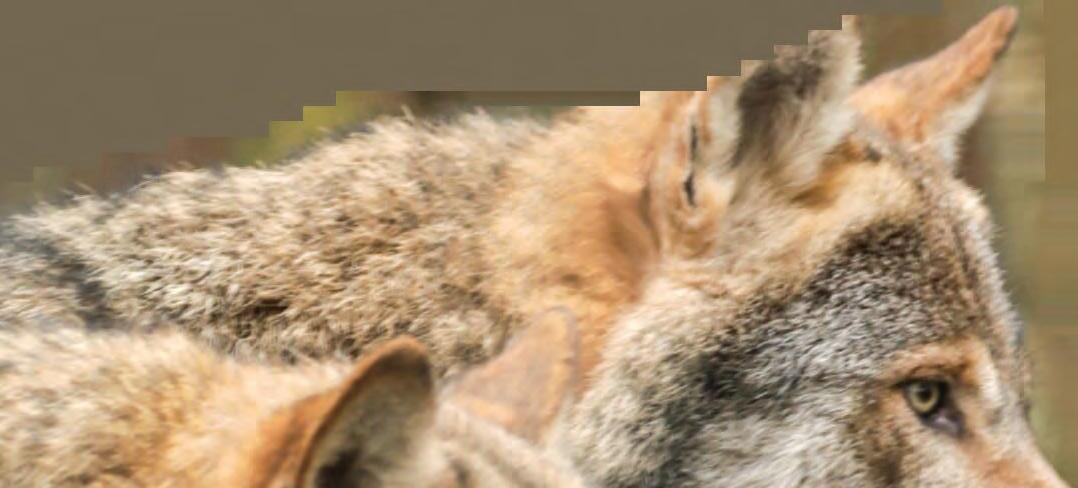


nee upon a time. wolves roamed the Scottish countryside, their haunting howls echoing across moors and mountains. They have been regionally extinct in Scotland for centuries. but if you take a trip to Highland WildlifePark.you'll find a furry foursome who look like they've leapt straight from the pages of a fairy tale. Forget everything Little Red Riding Hood has taught you about big, bad wolves. though. These much maligned animals have long been misunderstood. and the keepers who look after the park's wolves on a daily basis are keen to set the record straight.
Despite the wolves· voraciously carnivorous appetites and the fact that they have paws. not hooves. they're actually cared for by the hoofstock team. including animal team leader Morag Sellar and senior keeper Becky Pink
They've been part of their section for the past decade, but Highland Wildlife Park has had wolves since it opened in 1972."We've always had grey wolves
here, with packs of various sizes," says Becky. Nowadays, the band of brothers in Wolf Wood are European grey wolves named Merrick. Storr. Beinn and Chonzie. and they live contentedly as a small bachelor group.
"The four brothers get on really well," Becky continues. "Obviously there is the odd sibling squabble, but they all have different characteristics and work out their disagreements."
By encouraging the wolves to bound around on a regular basis. their bickering doesn't turn too nasty. "We exercise
Scent rolling is very important to wolves, so the pack at the park are given fragrant herbs and spices to scrabble around in as part of their regular enrichment.
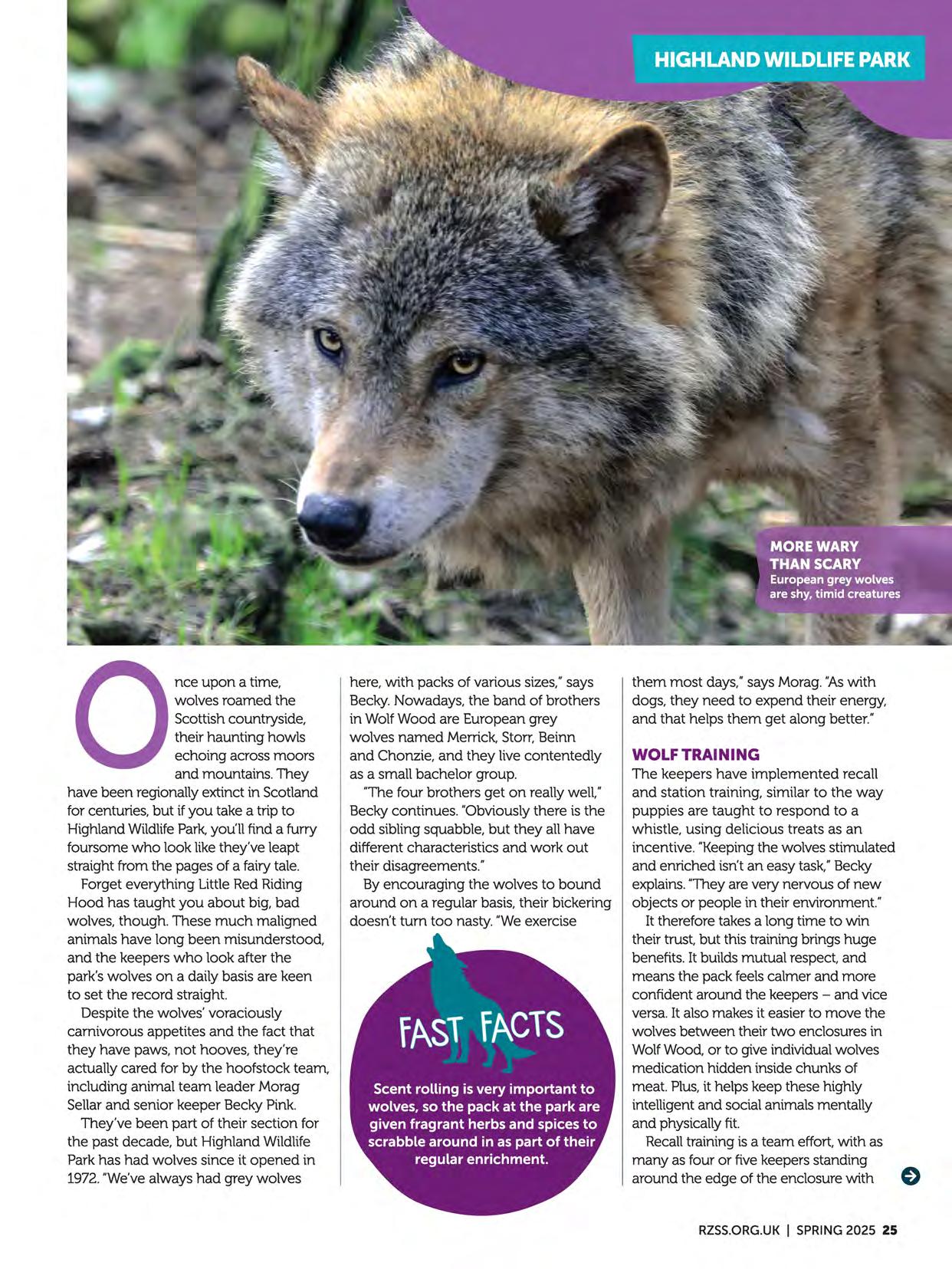
them most days," says Morag. "Aswith dogs, they need to expend their energy, and that helps them get along better."
The keepers have implemented recall and station training. similar to the way puppies are taught to respond to a whistle, using delicious treats as an incentive. "Keepingthe wolves stimulated and enriched isn't an easy task," Becky explains. "They are very nervous of new objects or people in their environment."
It therefore takes a long time to win their trust. but this training brings huge benefits. It builds mutual respect. and means the pack feels calmer and more confident around the keepers -and vice versa. It also makes it easier to move the wolves between their two enclosures in WolfWood. or to give individual wolves medication hidden inside chunks of meat. Plus. it helps keep these highly intelligent and social animals mentally and physically fit.
Recall training is a team effort, with as many as four or five keepers standing around the edge of the enclosure with 0
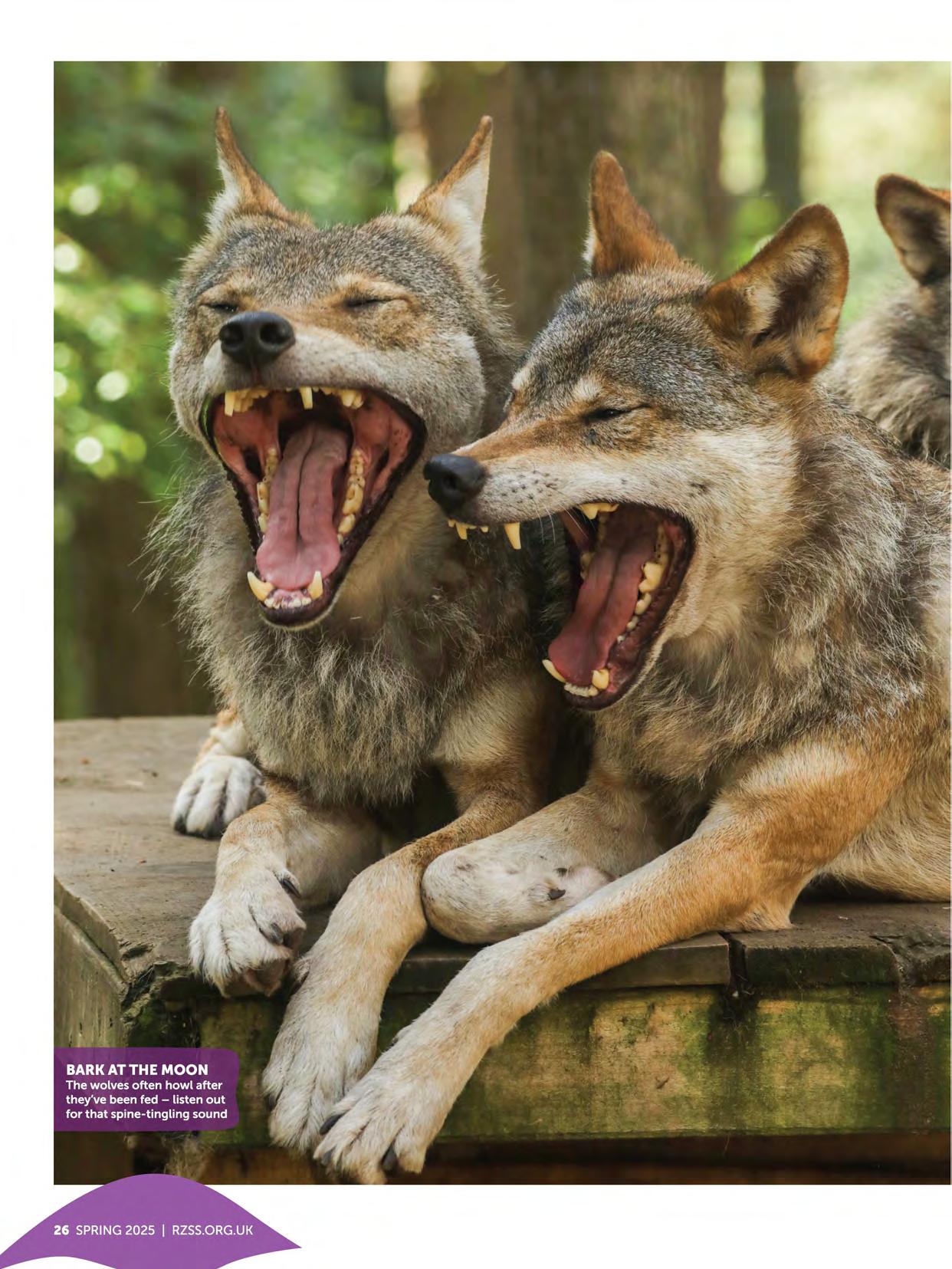
buckets of meat and their whistles. They'll then take it in turns to whistle and throw a handful of meat to attract the wolves in their direction -but they make sure to add in the odd pretend throw, too.
"The wolves are so smart, they're always watching where that food is going to come from, so we have to make sure that they're listening as well, because otherwise they'd just be running back and forth until they got some meat," says Becky.
When the keepers embarked on this training, it was a trailblazing way to work with wolves in captivity. "In the UK,no one had ever done recall with wolves before. A lot of the other zoos have taken on what we've been doing, and they also do recall with their wolves now."
It surprises some visitors to see how comfortable the keepers are with the wolves. "We'veworked really closely with them for the last ten years," explains Morag. "We respect the wolf and the wolf respects us. When we're in cleaning up, we never take food into the area, and we always go in two at a time. But we're really quite boring to the wolves!"
"Sometimes we're nearly run over by them," she laughs. "They're doing their own thing, chasing about, and they haven't even noticed us. That's the way we want them -they don't have to be worried about us at all."
It's certainly a far cry from the fearsome fanged beasts of folklore, but it's not only those old stories that have painted an inaccurate picture of wolveseven scientists have struggled to fully understand the complexities of their pack dynamics.
It was once widely believed that an alpha wolf or alpha pair led each pack, and that there was a fair amount of vicious in-fighting with the lower-ranking wolves to gain dominance. That thinking was based on studies of captive wolves, but it's now clear that their natural hierarchy is much simpler than that. "It'sjust a family group. It starts off with Mum and Dad, and then includes their offspring," Becky reveals.
There is, of course, one way in which wolves live up to their reputation, and that's at feeding time, when it becomes clear how the term 'wolfing it down'
11 The wolves are so smartl theyre always watching where that food is going to come from 11
Becky Pink, Senior Keeper

came about. "We give them around 30 to 40kg of food a week" says Becky,"and that's mostly venison. We get venison bones from the local game dealer, and they have a bit of meat on them, so that makes the wolves work at chewing the bones, the meat, the marrow. We'll also feed them pheasants and rabbits."
"We don't feed them every single day," Morag continues. "It'sa big meal, two or three times a week. They'll wolf down their food really, really fast, and then go about with huge bellies. That's the way they would eat in the wild. They watch out for us coming -they're constantly mooching for food!"
"When we give them a large carcass feed, they eat as much as they can and then cache the rest around their enclosure," adds Becky."On day two, they've still got full bellies, but by day three, they'll eat what they've cached, and by day four, they'll be starting to chew the bones. Then they'll get another big feed again."
If you're lucky, you might hear the wolves howling after they've been fed. Morag and Becky describe it as a sound like no other: "It'sabsolutely amazing to hear. The hairs on the back of your neck stand up. We've been in there when they're howling and it's really powerful. When one gets going, they'll all join in, they just can't help it. It's beautiful."
Even on days when the wolves aren't being fed or doing their recall training, they get plenty of enrichment in the form of intriguing smells, textures and other bits and bobs to investigate, such as a whole deer skin to demolish.
It can, though, take ages for them to get used to unfamiliar objects, as Becky explains: "If you put anything new in, such as a big blue barrel, they're scared of it for a few days until one of them is brave enough to investigate and eventually start enjoying the new objects!"
There are currently six keepers caring for the wolves, and it understandably takes a while for new people to be accepted by the pack.
"We'veworked so hard to get the wolves used to us and settled around us. They know us really well,"Becky says. Body language can do a lot to reassure

the more nervous members of the pack that they're among friends, not foes.
"When we're going up there, we have to take a breath and just relax and focus. That relaxes our postures, which in tum makes the wolves relax. We try not to give them too much eye contact because for a wolf, that's quite scary. We don't want to be a threat to them, or be imposing. It's their territory, so we don't want to encroach on it. We're nice and calm around them, and that definitely shows in the way they trust the six of us."
Becky adds, "We'veput time and effort into them. We knew it wouldn't be quick but it took years. Our consistency has paid off for these timid, misunderstood animals."
"I think the team should be very proud of themselves and what they've achieved," agrees Morag.
Together, the keepers from the hoofstock team are helping to rewrite the myth of the menacing, murderous wolf, teaching visitors that these handsome chaps are shy, not sly, and much more wary than scary.
It's hoped that the brothers, who are all five and six years old, will be at Highland WildlifePark for the rest of their lives.Thanks to the patience, care and dedication of their keepers, these wolves have found their happily ever after.



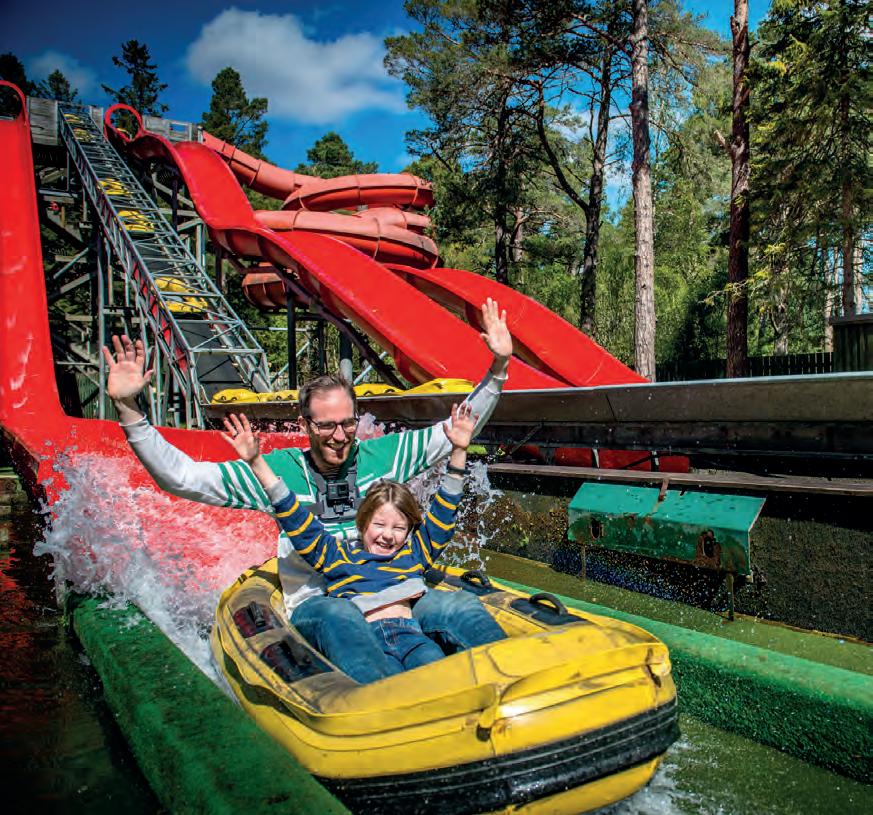
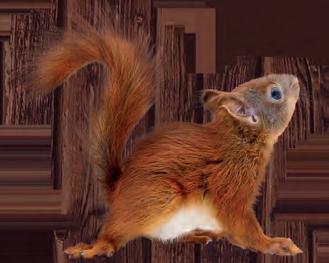

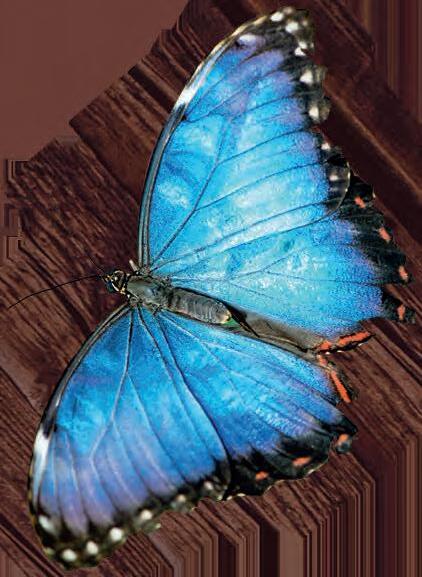



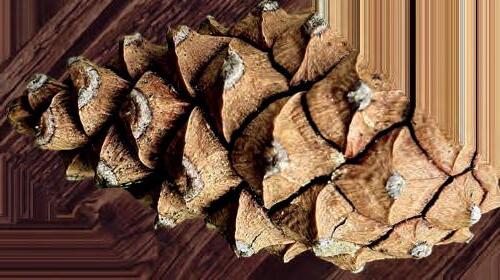


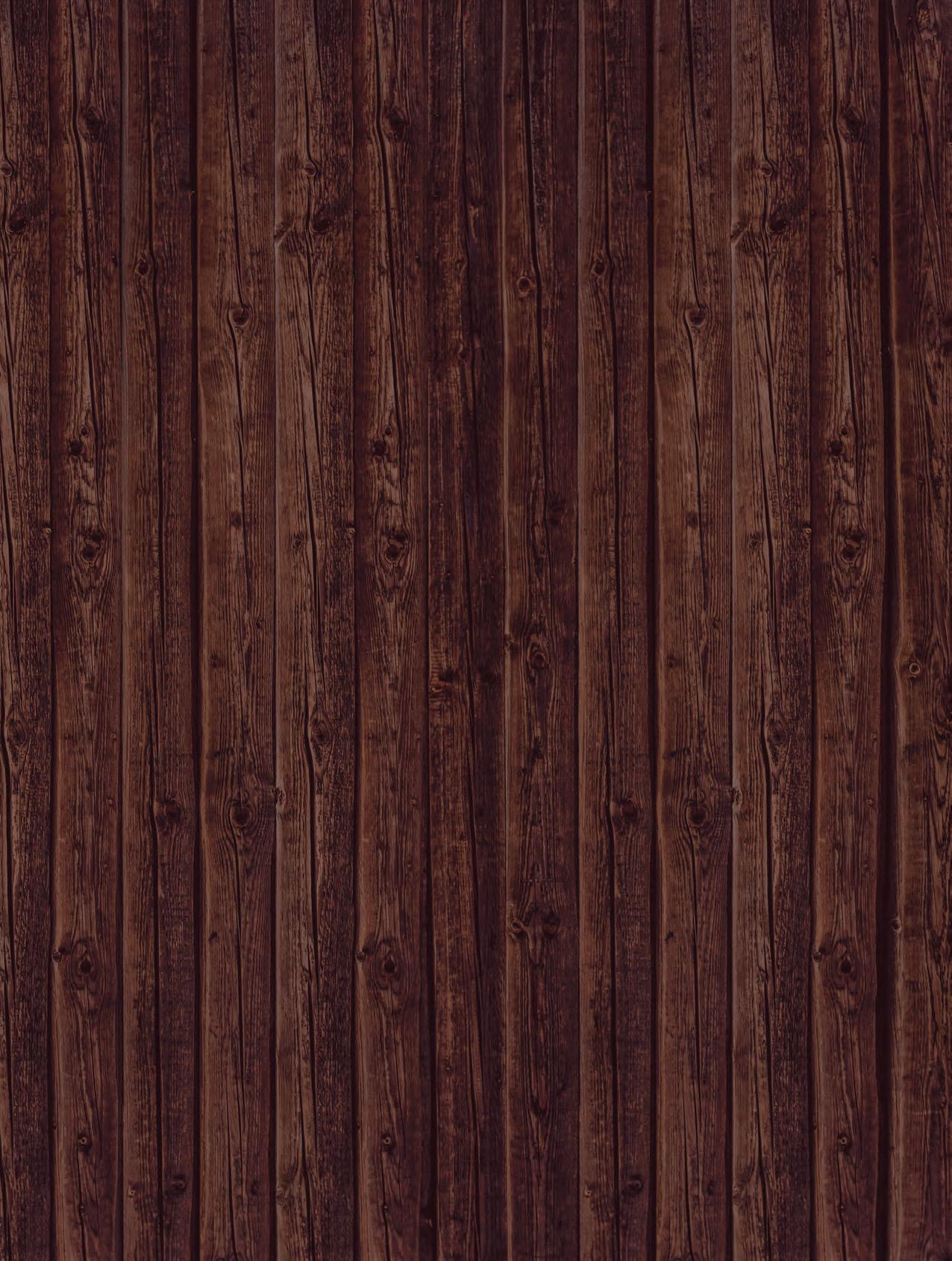
Jonathan McIntosh discovers how this feisty young animal has taken the world by storm
Mave over Scotland's national dish, the country has a new icon with the same name: Haggis the pygmy hippo.
Since arriving on Wednesday 30 October 2024, Haggis has caused a huge stir at Edinburgh Zoo -something that Jonny Appleyard, hooftstock team leader, couldn't have predicted.
"Back in February 2024 we suspected Haggis's mum, Gloria, was pregnant. We did ultrasounds, but it's difficult to get clear results due to the thickness of hippos' skin," explains Jonny. "When Gloria began isolating and getting angsty with dad Otto, we knew she was expecting."
Hippos are pregnant for six to seven months. Usually they give birth overnight, but Gloria had other plans.
"Gloria surprised us by having Haggis outside in the pool at 3pm! Scottish weather is too cold for a pygmy hippo waterbirth, so we took them inside to warm up," says Jonny. "Within 24 hours the pair had bonded nicely."
Because they need to gain 500 grams a day to grow healthily, newborn pygmy hippos must learn how to feed quickly. Jenny's team ensured Haggis and Gloria had everything they required.
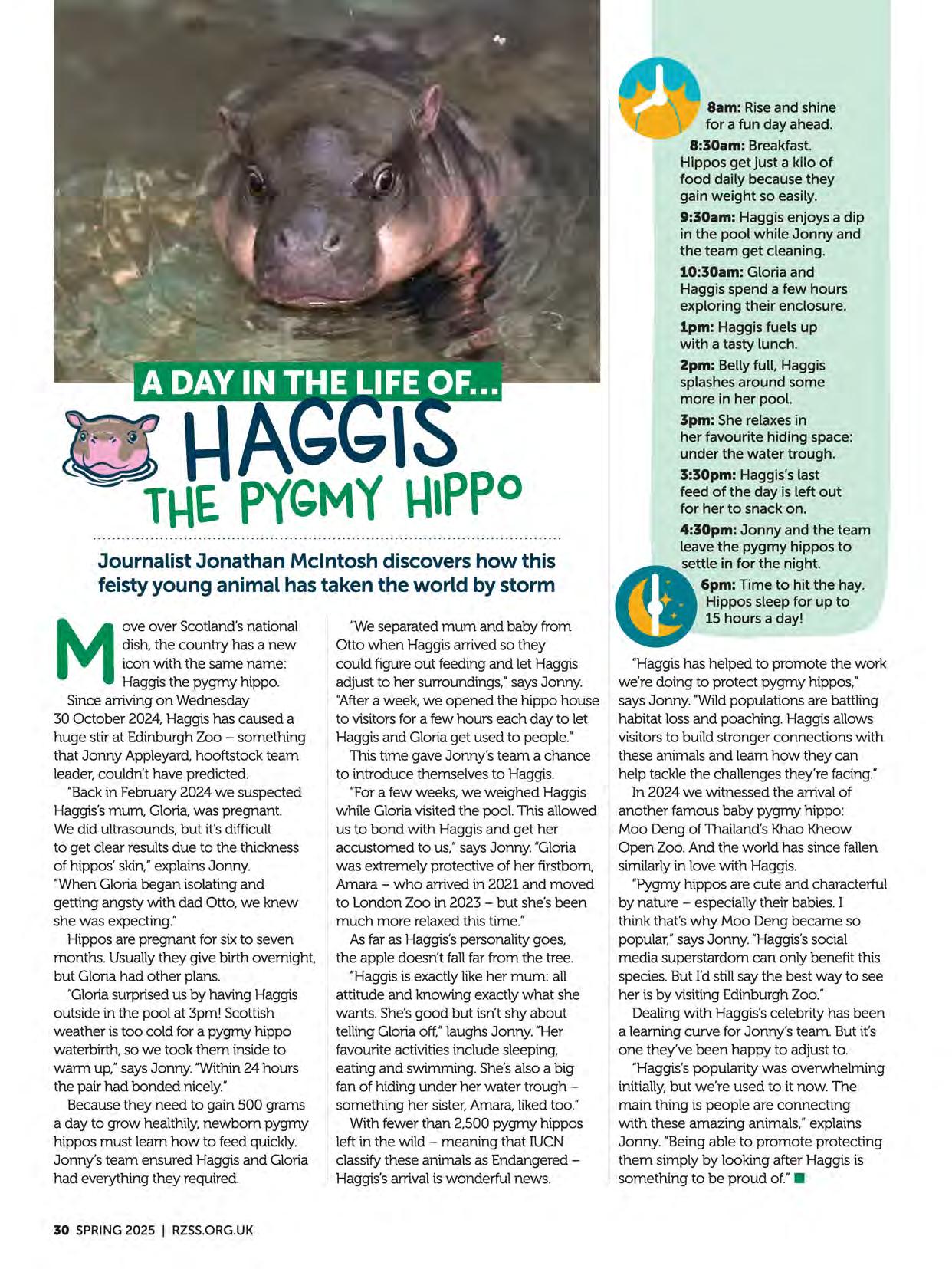
"We separated mum and baby from Otto when Haggis arrived so they could figure out feeding and let Haggis adjust to her surroundings," says Jonny. "After a week, we opened the hippo house to visitors for a few hours each day to let Haggis and Gloria get used to people."
This time gave Jenny's team a chance to introduce themselves to Haggis.
"For a few weeks, we weighed Haggis while Gloria visited the pool. This allowed us to bond with Haggis and get her accustomed to us," says Jonny. "Gloria was extremely protective of her firstborn, Amara -who arrived in 2021 and moved to London Zoo in 2023 -but she's been much more relaxed this time."
As far as Haggis's personality goes, the apple doesn't fall far from the tree.
"Haggis is exactly like her mum: all attitude and knowing exactly what she wants. She'sgood but isn't shy about telling Gloria off," laughs Jonny. "Her favourite activities include sleeping, eating and swimming. She'salso a big fan of hiding under her water troughsomething her sister, Amara, liked too."
With fewer than 2,500 pygmy hippos left in the wild -meaning that IUCN classify these animals as EndangeredHaggis's arrival is wonderful news.
8am: Rise and shine for a fun day ahead.
8:30am: Breakfast. Hippos get just a kilo of food daily because they gain weight so easily.
9:30am: Haggis enjoys a dip in the pool while Jonny and the team get cleaning.
10:30am: Gloria and Haggis spend a few hours exploring their enclosure.
1pm: Haggis fuels up with a tasty lunch.
2pm: Belly full, Haggis splashes around some more in her pool.
3pm: She relaxes in her favourite hiding space: under the water trough.
3:30pm: Haggis's last feed of the day is left out for her to snack on.
4:30pm: Jonny and the team leave the pygmy hippos to settle in for the night.
6pm: Time to hit the hay. Hippos sleep for up to 15 hoursa day!
"Haggis has helped to promote the work we're doing to protect pygmy hippos," says Jonny. "Wild populations are battling habitat loss and poaching. Haggis allows visitors to build stronger connections with these animals and learn how they can help tackle the challenges they're facing."
In 2024 we witnessed the arrival of another famous baby pygmy hippo: Moo Deng of Thailand's Khao Kheow Open Zoo. And the world has since fallen similarly in love with Haggis.
"Pygmy hippos are cute and characterful by nature -especially their babies. I think that's why Moo Deng became so popular," says Jonny. "Haggis's social media superstardom can only benefit this species. But I'd still say the best way to see her is by visiting Edinburgh Zoo."
Dealing with Haggis's celebrity has been a learning curve for Jenny's team. But it's one they've been happy to adjust to.
"Haggis's popularity was overwhelming initially, but we're used to it now. The main thing is people are connecting with these amazing animals," explains Jonny. "Being able to promote protecting them simply by looking after Haggis is something to be proud of."

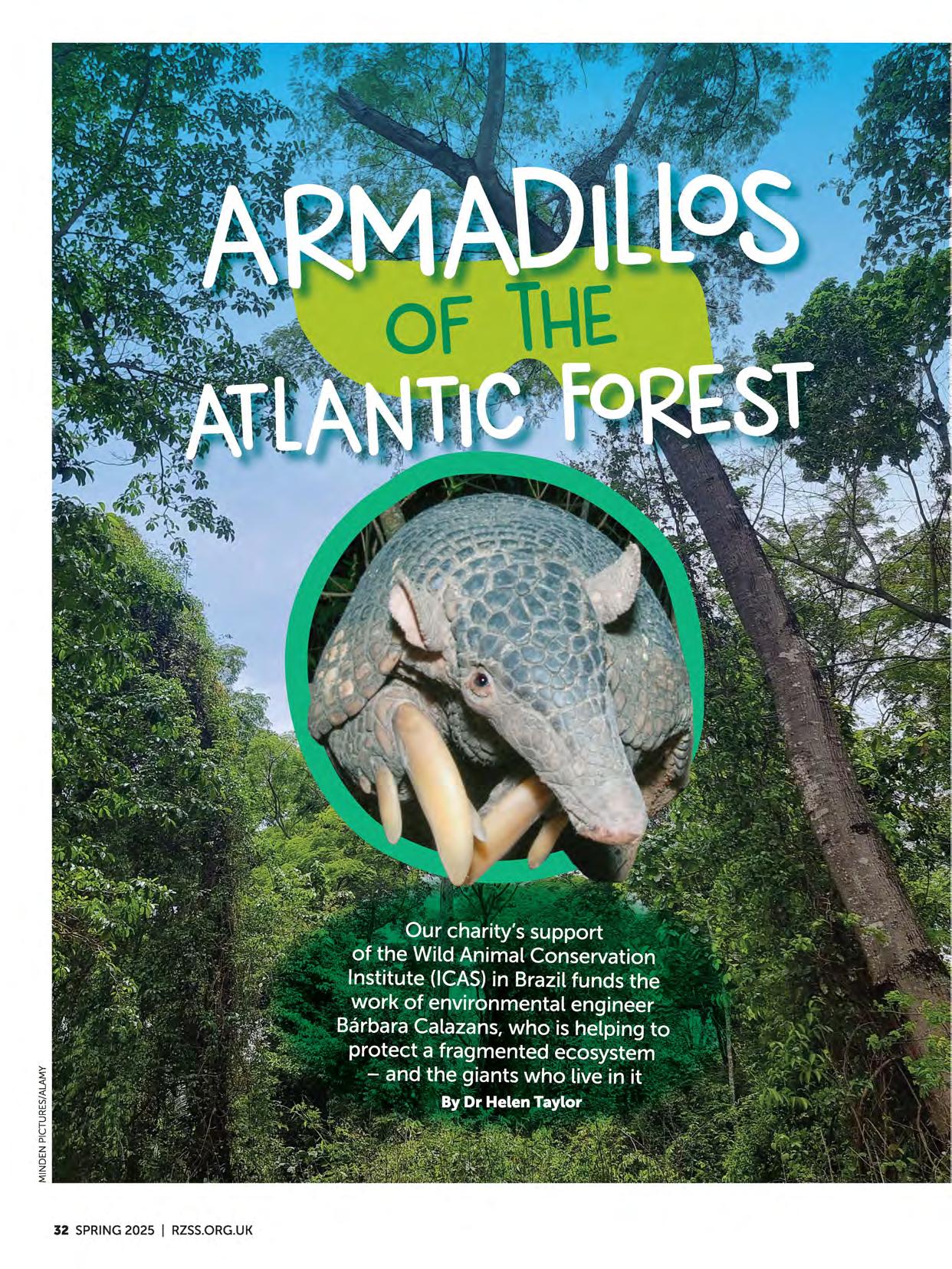
hink Brazilian jungle and you'll probably think of the Amazon, but the country is also home to another equally special and threatened forest. The Atlantic Forest ecosystem that once ran along the coastline from the north-east of Brazil all the way through to Argentina and Paraguay is home to incredible biodiversity, some of which is found nowhere else on the planet. This ecosystem has been extremely fragmented by deforestation. Today, just 12% of its original area remains.
Our long-term conservation partners, the Wild Animal Conservation Institute (ICAS),headed up by Dr Arnaud Desbiez, recently added the Atlantic Forest to their focal sites for
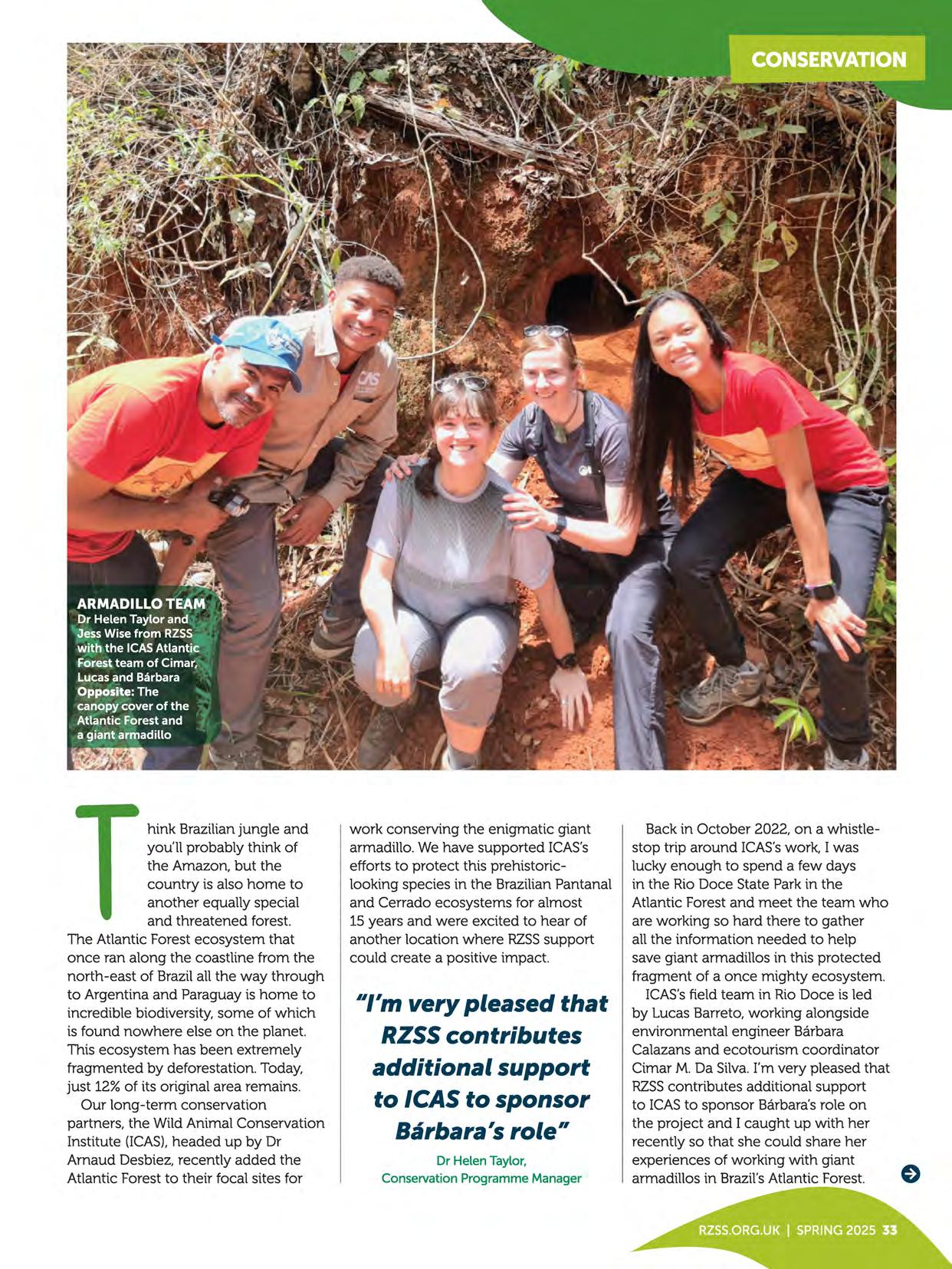
work conserving the enigmatic giant armadillo. We have supported ICAS's efforts to protect this prehistoriclooking species in the Brazilian Pantanal and Cerrado ecosystems for almost 15 years and were excited to hear of another location where RZSSsupport could create a positive impact.
11 /'m very pleased that RZSS contributes additional support to ICAS to sponsor Barbara's role"
Dr Helen Taylor, ConservationProgramme Manager
Back in October 2022, on a whistlestop trip around ICAS'swork, I was lucky enough to spend a few days in the Rio Dace State Park in the Atlantic Forest and meet the team who are working so hard there to gather all the information needed to help save giant armadillos in this protected fragment of a once mighty ecosystem.
ICAS'sfield team in Rio Dace is led by Lucas Barreto, working alongside environmental engineer Barbara Calazans and ecotourism coordinator Cimar M. Da Silva. I'm very pleased that RZSScontributes additional support to ICASto sponsor Barbara's role on the project and I caught up with her recently so that she could share her experiences of working with giant armadillos in Brazil's Atlantic Forest. 0
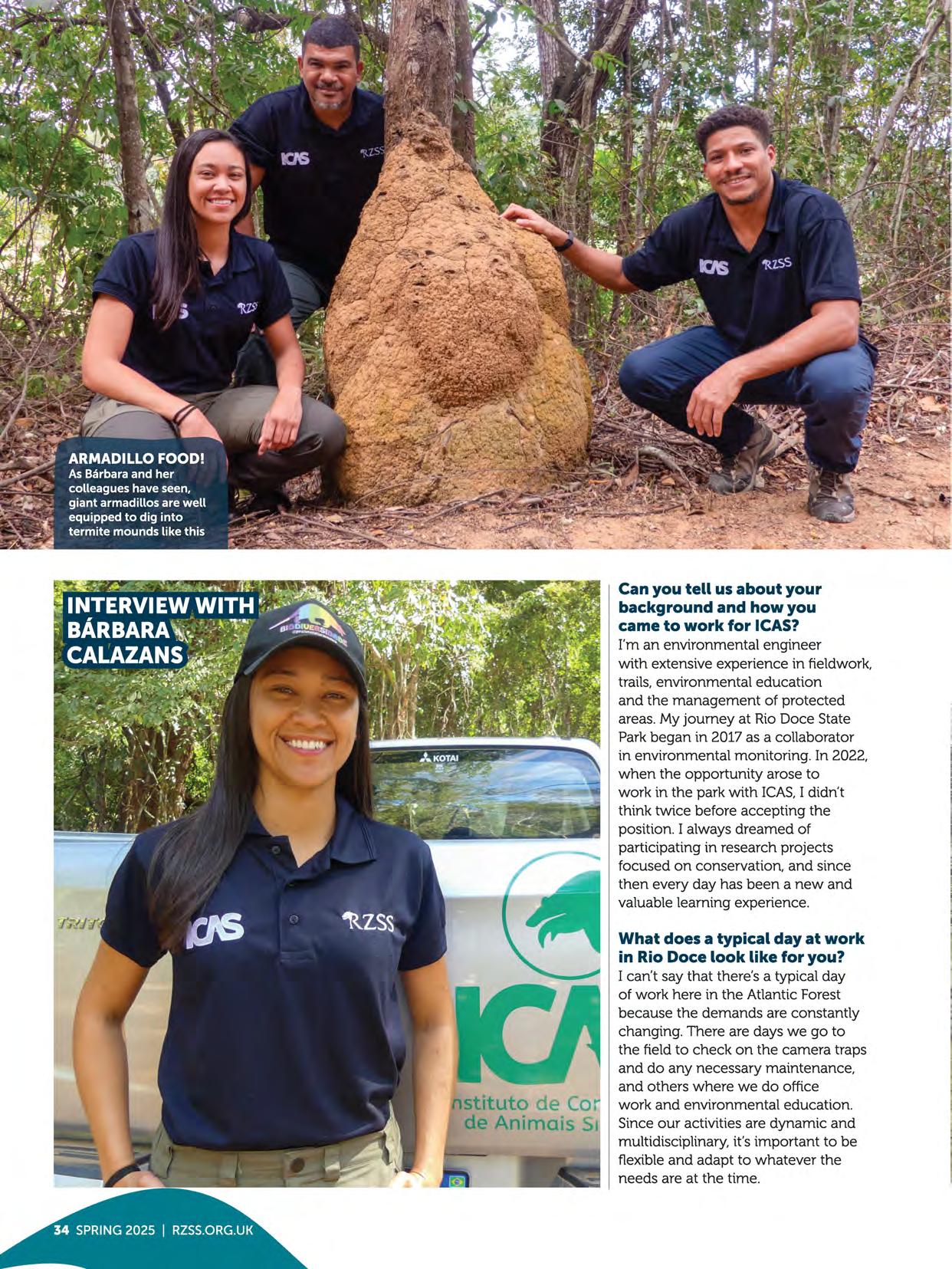
Can you tell us about your background and how you came to work for ICAS?
I'm an environmental engineer with extensive experience in fieldwork, trails, environmental education and the management of protected areas. My journey at Rio Doce State Park began in 2017 as a collaborator in environmental monitoring. In 2022, when the opportunity arose to work in the park with ICAS,I didn't think twice before accepting the position. I always dreamed of participating in research projects focused on conservation, and since then every day has been a new and valuable learning experience.
What does a typical day at work in Rio Doce look like for you?
I can't say that there's a typical day of work here in the Atlantic Forest because the demands are constantly changing. There are days we go to the field to check on the camera traps and do any necessary maintenance, and others where we do office work and environmental education. Since our activities are dynamic and multidisciplinary, it's important to be flexible and adapt to whatever the needs are at the time.
What are your favourite things that you see in the forest at Rio Doce?
Walking through the forest is always a magical experience. I love admiring the presence of ancient trees and feeling their centuriesold stories. Unexpected encounters with wild animals touch my heart because of how rare these moments can be. This direct connection with nature is truly special.
What makes giant armadillos so special? Why is it important to protect them?
The giant armadillo is on both the national and global lists of threatened species, being classified as Vulnerable. In the Atlantic Forest biome specifically, it is critically endangered, occurring in just two locations: the Sooretama Biological Reserve and the Rio Doce State Park. From 2018 to 2020, data from the Sooretama region showed that the species was at severe risk of extinction.
11 The giant armadillo is on both the national and global lists of threatened species 11
Barbara Calazans, Environmental Engineer
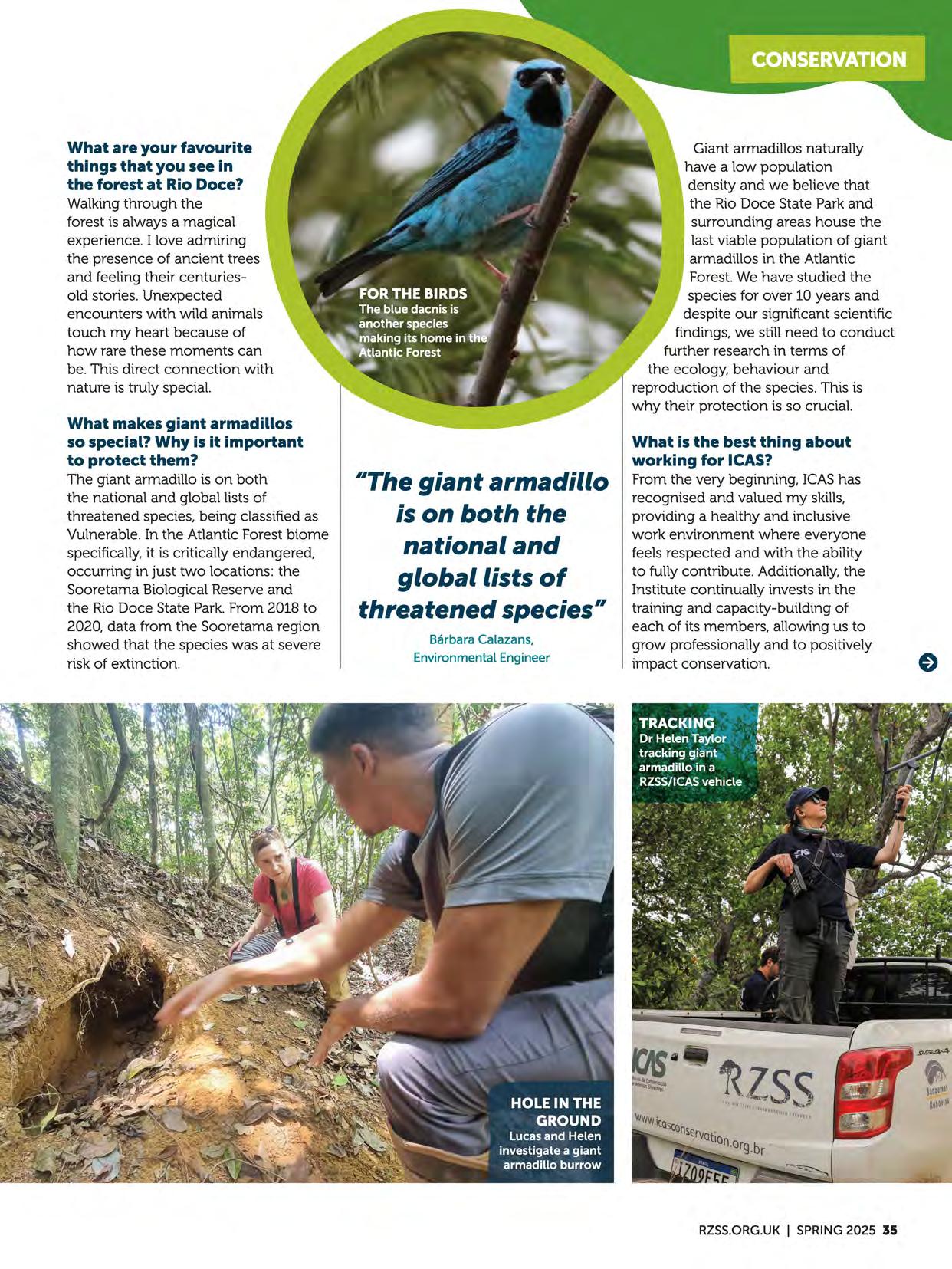
Giant armadillos naturally have a low population density and we believe that the Rio Doce State Park and surrounding areas house the last viable population of giant armadillos in the Atlantic Forest. We have studied the species for over 10 years and despite our significant scientific findings, we still need to conduct further research in terms of the ecology, behaviour and reproduction of the species. This is why their protection is so crucial.
What is the best thing about working for ICAS?
From the very beginning, ICAShas recognised and valued my skills, providing a healthy and inclusive work environment where everyone feels respected and with the ability to fully contribute. Additionally, the Institute continually invests in the training and capacity-building of each of its members, allowing us to grow professionally and to positively impact conservation.
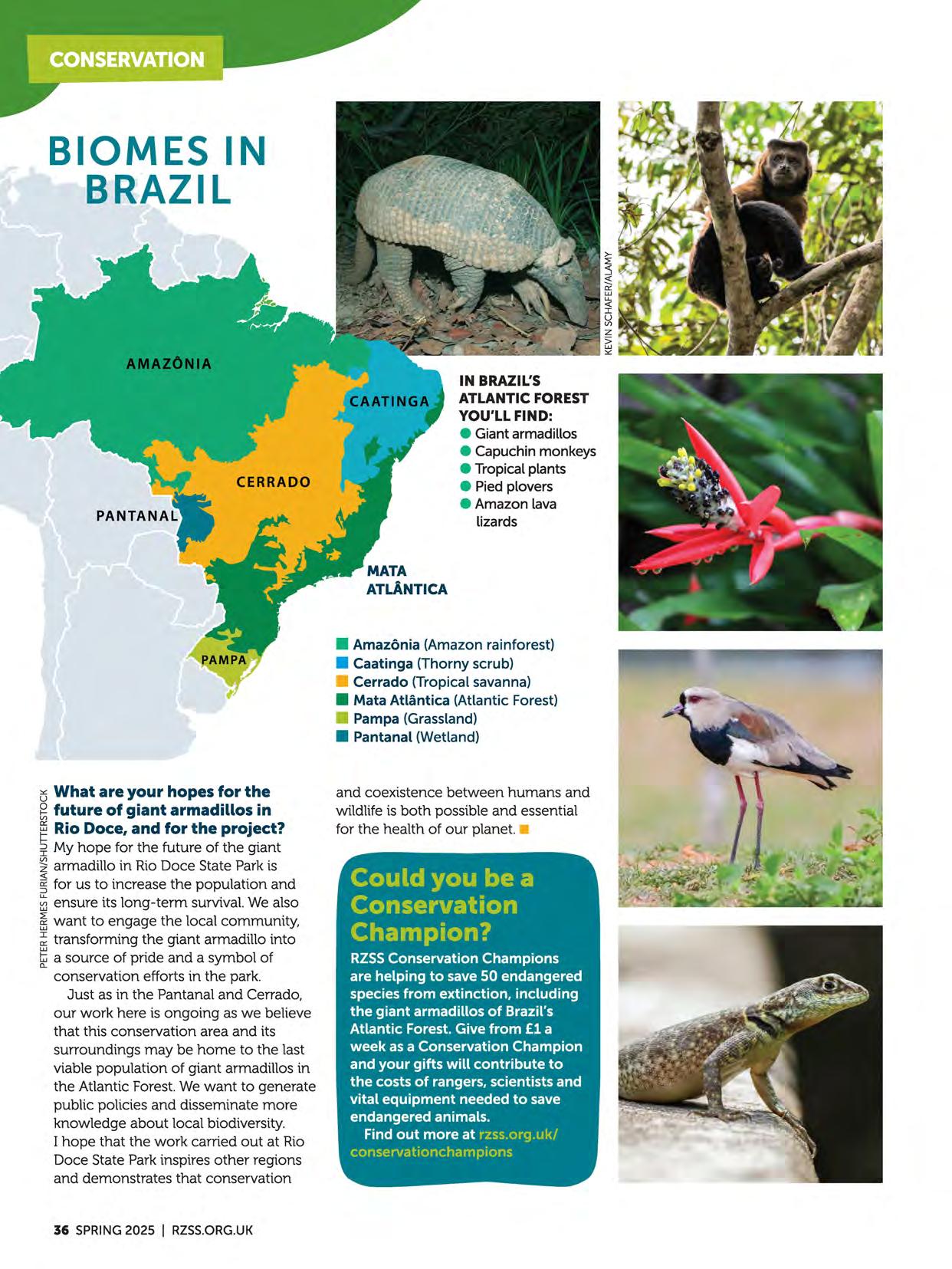
IN BRAZIL'S ATLANTIC
YOU'LL FIND:
• Giant armadillos
• Capuchin monkeys
• Tropical plants
• Pied plovers
• Amazon lava lizards
Amazonia (Amazon rainforest)
Caatinga (Thorny scrub)
Cerrado (Tropical savanna)
Mata Atlantica (Atlantic Forest) Pampa (Grassland)
Pantanal (Wetland)
0 What are your hopes for the future of giant armadillos in Rio Doce, and for the project?
i My hope for the future of the giant armadillo in Rio Doce State Park is for us to increase the population and ensure its long-term survival. We also want to engage the local community, transforming the giant armadillo into a source of pride and a symbol of ()._ conservation efforts in the park
Just as in the Pantanal and Cerrado, our work here is ongoing as we believe that this conservation area and its surroundings may be home to the last viable population of giant armadillos in the Atlantic Forest. We want to generate public policies and disseminate more knowledge about local biodiversity. I hope that the work carried out at Rio Doce State Park inspires other regions and demonstrates that conservation
and coexistence between humans and wildlife is both possible and essential for the health of our planet.
RZSS Conservation Champions are helping to save 50 endangered species from extinction, including the giant armadillos of Brazil's Atlantic Forest. Give from £1 a week as a Conservation Champion and your gifts will contribute to the costs of rangers, scientists and vital equipment needed to save endangered animals.
Find out more at rzss.org.uk/ conservationchampions

Visit Highland Wildlife Parkto see our Arctic quartet, Victoria, Brodie,Arktos and Walker
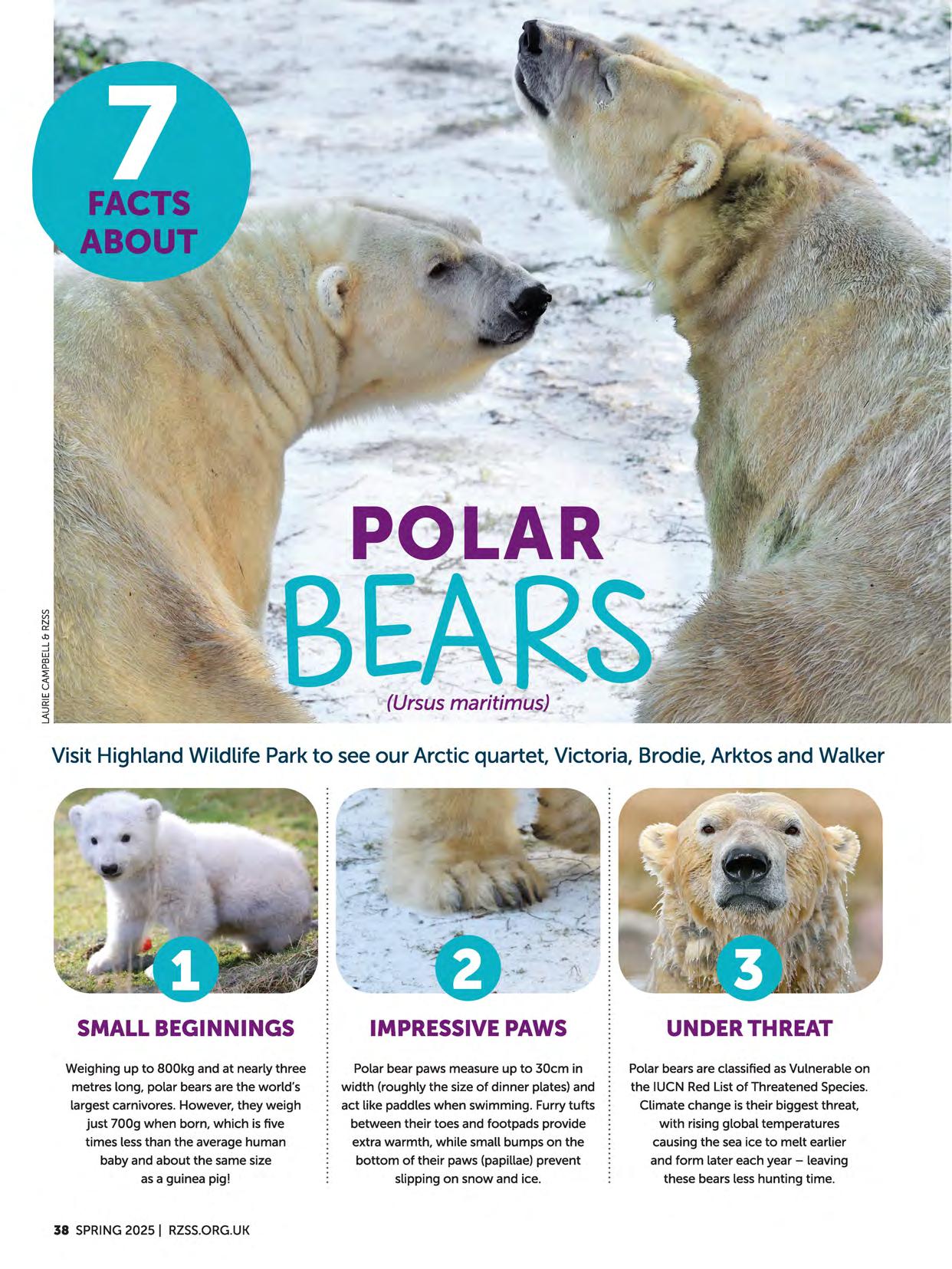
Weighing up to 800kg and at nearly three metres long, polar bears are the world's largest carnivores. However, they weigh just 700g when born, which is five times less than the average human baby and about the same size as a guinea pig!
Polar bear paws measure up to 30cm in width (roughly the size of dinner plates) and act like paddles when swimming. Furry tufts between their toes and footpads provide extra warmth, while small bumps on the bottom of their paws (papillae) prevent slipping on snow and ice.
Polar bears are classified as Vulnerable on the IUCN Red List of Threatened Species. Climate change is their biggest threat, with rising global temperatures causing the sea ice to melt earlier and form later each year -leaving these bears less hunting time.
These bears prey mainly on ringed and bearded seals, which they hunt by breaking into pupping dens, waiting at breathing holes and stalking those that've stopped on the ice. Polar bears also scavenge carcasses and eat small mammals, eggs, birds and vegetation.
Polar bears have adjusted extremely well to Arctic climates. Their thick translucent fur reflects light to help them camouflage with their surroundings, while a blubber layer keeps them warm in chilly air and water. The jet-black skin under their coat also helps to soak up the sun's rays.
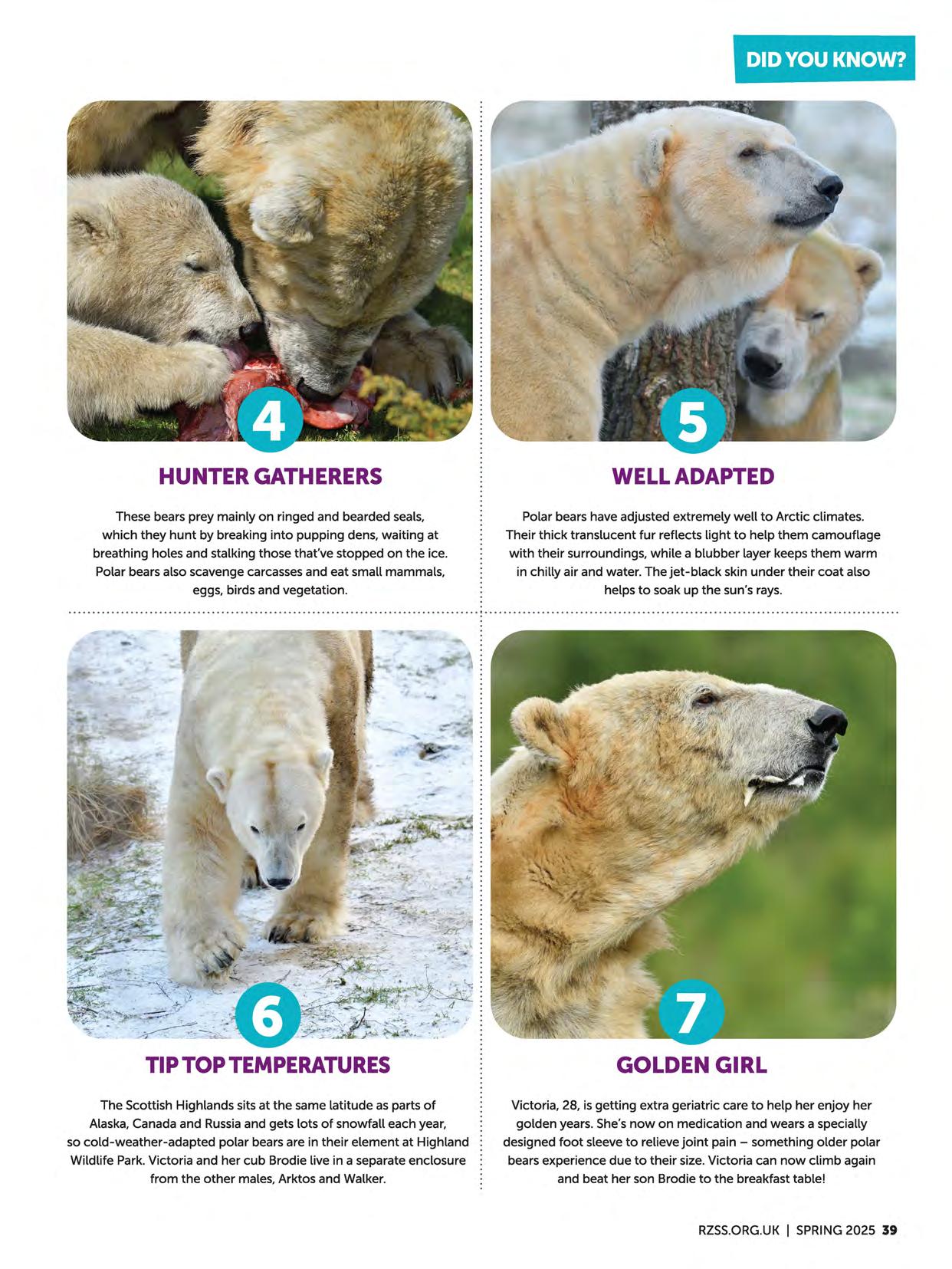
The Scottish Highlands sits at the same latitude as parts of Alaska, Canada and Russiaand gets lots of snowfall each year, so cold-weather-adapted polar bears are in their element at Highland Wildlife Park. Victoria and her cub Brodie live in a separate enclosure from the other males, Arktos and Walker.
Victoria, 28, is getting extra geriatric care to help her enjoy her golden years. She's now on medication and wears a specially designed foot sleeve to relieve joint pain -something older polar bears experience due to their size. Victoria can now climb again and beat her son Brodie to the breakfast table!

Alex and Ros Javed first visited Highland Wildlife Park on their son's fifth birthday back in in 1998. After that, the family made yearly pilgrimages to the park from their home in Surrey until they relocated to Inverness in 2012, signing up as RZSS members when they did so. After becoming Patrons of our charity in 2019, they've reaped the benefits of extra-special access to our animals ever since.
What do you love the most about Highland Wildlife Park?
Alex: We've benefited so much from our visits over the years. The park's an hour's drive from us, so we call in as often as we can. It's always great to visit because it gets you out into nature and up close to the amazing animals RZSSlooks after. I'm a keen photographer and I've snapped thousands of pictures here. We've got loads of Hamish the polar bear as well as his little brother, Brodie. The staff are just so helpful and passionate about the animals they care for and are always happy to chat about what they're doing. I think this really shines through when you're here. When we bring family and friends to visit, they always say to us: "We see why you like it so much!". Ros: We have a specific routine every time we visit Highland Wildlife Park -even if we're short on time or if the weather is bad. We always make sure to see the European grey wolves. the Amur tigers. and the polar bears. Highland Wildlife Park is so green and has beautiful views of the mountains. I love how RZSShas adapted its environments to suit the animals.
What made you become Patrons?
Alex: Having visited so often. we've witnessed firsthand how Highland Wildlife Park has developed over the years. Seeing how the animal environments have been continually improved has been special. But we understand that these changes require a lot of investment. When our son left home, Ros and I felt we were able to give more to support RZSS.That's why we decided to become Patrons in 2019. We get a lot of pleasure from visiting Highland Wildlife Park, so being able to help further is a win-win.
What activities have you enjoyed so far as Patrons?
Alex: We've been on quite a few of RZSS's Patron experience events. We attended the pre-opening event for Edinburgh Zoo's giraffe house, which was fabulous. We also went down to say goodbye to the pandas, Yang Guang and Tian Tian. More recently, we also said hello to Edinburgh Zoo's penguin chicks, who were as fluffy and entertaining as you can imagine! We would never have learned about pine hoverflies if it wasn't for these Patron events. I've since fallen in love with these creatures. Ros: Being a Patron has allowed us to do things we never thought we'd ever get the chance to. RZSS'schief executive organised for us to feed the older male polar bears, Walker and Arktos, because I mentioned how much I loved them.

What do you enjoy most as a Patron?
Alex: I'd say it's the behind-the-scenes access and knowledge. It provides you with extra chances to speak to keepers about the animals' care and characteristics.
Ros: Until you experience events such as these, I don't think you really appreciate the amount of work RZSSputs in to looking after the animals in its care.
What advice would you give to people considering becoming Patrons?
Alex: We're just as enthusiastic about Highland Wildlife Park today as we were when we first visited all those years ago. With exclusive events, behind-the-scenes tours, and unlimited access to Edinburgh Zoo and Highland Wildlife Park, becoming a Patron quickly pays for itself.
Ros: Being a Patron not only makes you feel closer to the work RZSSis doing, but it's also another way to support the charity's mission to care for and conserve wildlife while educating and empowering people to protect. value and love nature. We get so many benefits from being Patrons and can't recommend it highly enough.
For more information on becoming a Patron, visit rzss.org.uk/patrons


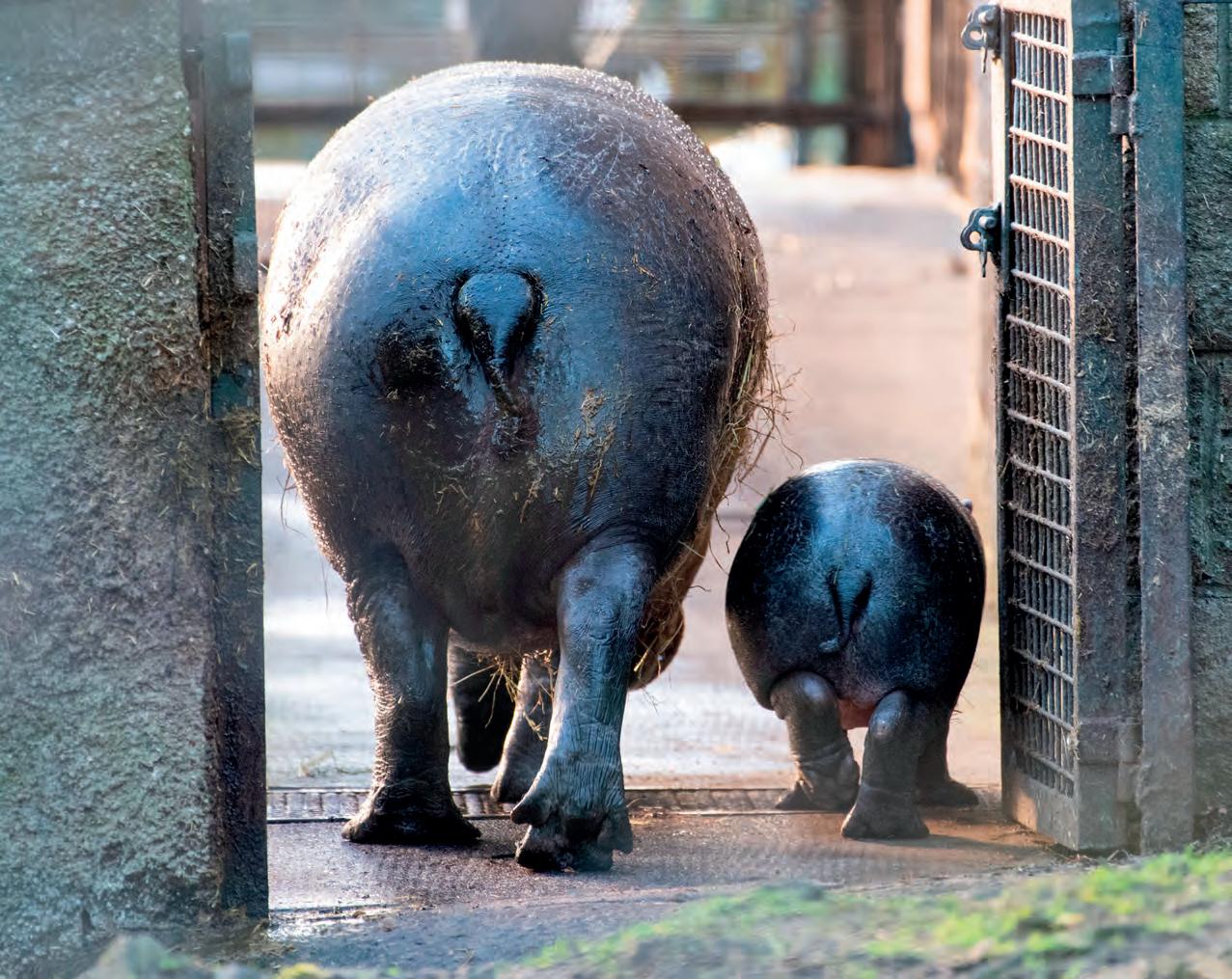
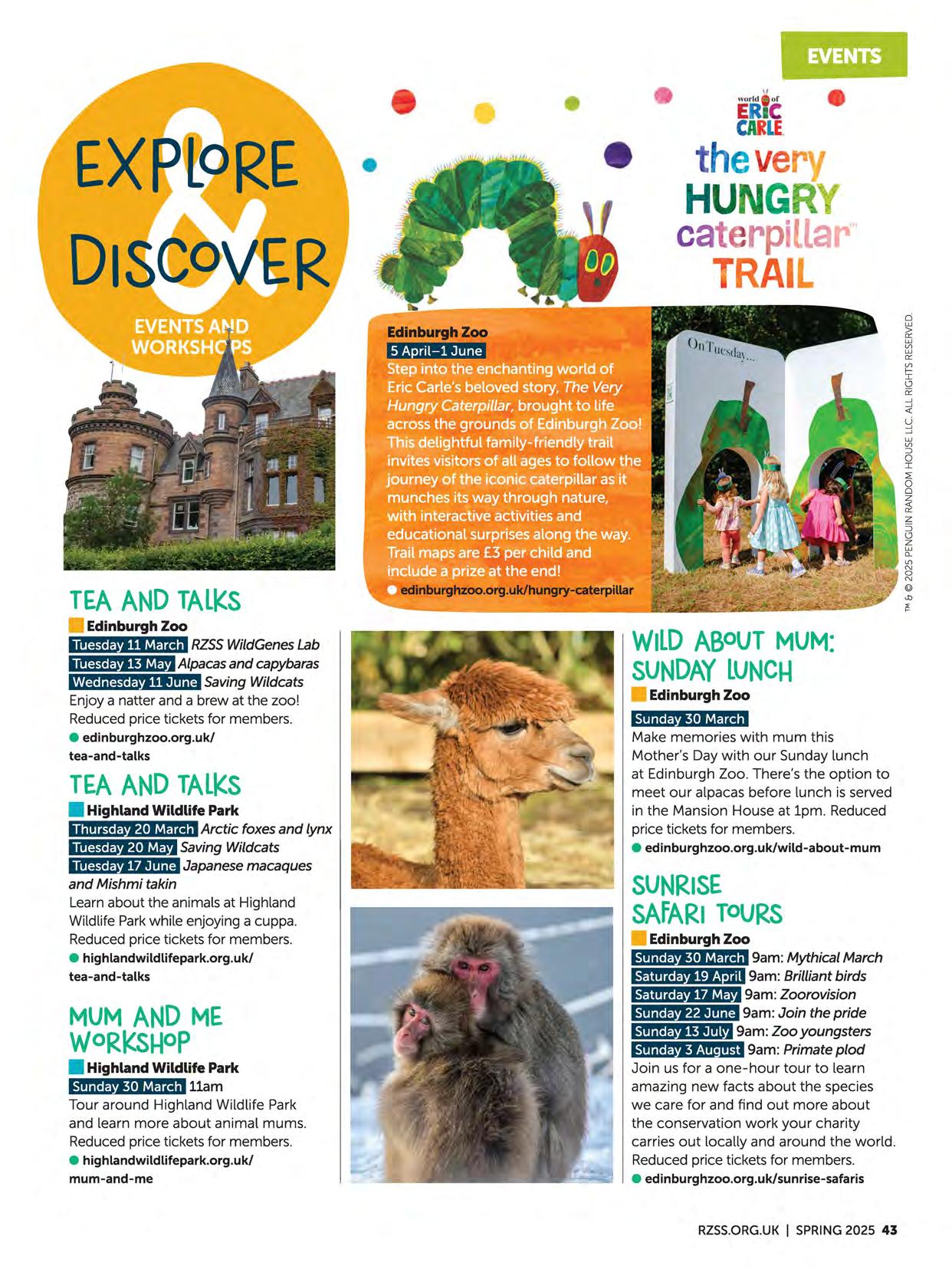
Edinburgh Zoo
Tuesday 11 March RZSSWildGenesLab Alpacasand capybaras
Tuesday 13 May
Wednesday 11 June SavingWildcats
Enjoy a natter and a brew at the zoo! Reduced price tickets for members.
• edinburghzoo.org.uk/ tea-and-talks
Thursday 20 March
Tuesday 20 May
Tuesday 17 June
Highland Wildlife Park Arctic foxesand lynx SavingWildcats Japanesemacaques and Mishmi takin
Learn about the animals at Highland Wildlife Park while enjoying a cuppa. Reduced price tickets for members.
• highlandwildlifepark.org.uk/ tea-and-talks
W0 RKs1-1°P
Highland Wildlife Park
Sunday 30 March 11am
Tour around Highland Wildlife Park and learn more about animal mums. Reduced price tickets for members.
• highlandwildlifepark.org.uk/ mum-and-me
Edinburgh Zoo
Sunday 30 March
Make memories with mum this Mother's Day with our Sunday lunch at Edinburgh Zoo. There's the option to meet our alpacas before lunch is served in the Mansion House at 1pm. Reduced price tickets for members.
• edinburghzoo.org.uk/wild-about-mum
Edinburgh Zoo
Sunday 30 March
Saturday 19 April
Saturday 17 May
9am: MythicalMarch 9am: Brilliantbirds 9am: Zoorovision
Sunday 22 June
Sunday 13 July
9am: Join the pride 9am: Zoo youngsters
Sunda 3 Au ust 9am: Primateplod
Join us for a one-hour tour to learn amazing new facts about the species we care for and find out more about the conservation work your charity carries out locally and around the world. Reduced price tickets for members.
• edinburghzoo.org.uk/sunrise-safaris
Highland Wildlife Park
Saturday 19 April 9am
Join us for a special pastry breakfast this Easter weekend with crafts and activities for all the family to enjoy. Peter Rabbit will also be around for families to meet. Reduced price tickets for members.
• highlandwildlifepark.org.uk/ bunnies-and-buns
~UGI-ILAND
Wildlife Park
Saturday 19 April 9am
Highland Wildlife Park i-Wil•mt
Join us this April to spot the eggs hidden among the park's enclosures. Complete the trail and win a prize! Trail maps are £2 per person.
• highlandwildlifepark.org.uk/ egg-stravaganza

Hop to the park and keep up with the mischievous Peter Rabbit! With regular appearances from Peter throughout the day, make sure to check our website for where he'll be and when. Free with zoo entry or RZSSmembership.
• highlandwildlifepark.org.uk/ peter-rabbit
26 and 27 April
Highland Wildlife Park 10 and 11 April 9am
25 and 26 September 9am
Our much-loved full-day photography workshops are back for 2025. Reduced price tickets for members.
• highlandwildlifepark.org.uk/ nature-photography-workshops
Big bird weekender
Wednesday 28 May
Otter day
Saturday 28 June
Colours in nature for pride
Monday 14 July
All about the chimps and research
Monday 21 July
Enrichment for the animals
Friday 1 August
Conservation
Highland Wildlife Park 11,e,ww1pm-3pm
This Easter we're offering the chance for children to get a taste of what it's like to be a zookeeper with our exciting twohour Junior Highland Keeper experience! Reduced price tickets for members.
• highlandwildlifepark.org.uk/ junior-highland-keeper
27 and 28 September
Australian animal weekender
On selected dates, we're hosting celebration days with themed talks. pop-up engagement activities and crafts relating to different zoo topics. Free with zoo entry or RZSS membership.
edinburghzoo.org.uk/ wild-discovery-days
Edinburgh Zoo Fi.fhi•IFHt'M10am-4pm
Stop by Lemur Lodge this spring to visit our market! Along with our plant sale and stalls from local traders. we'll be hosting talks by zoo gardeners to provide hints and tips for getting your garden ready for summer. Make sure to check our website in May for talk timings.Freewith zoo
N 0 entry or RZSSmembership.
u J:, w • edinburghzoo.org.uk/spring-market
Edinburgh Zoo 0 w 8' @ Rocking out with Robbie Williams at Murrayfield? Start your evening in style with a special pre-concert experience at Edinburgh Zoo. Savour a selection of cheese or charcuterie platters. paired with a glass of wine, as you take in the serene ambience of the Mansion House. Reduced price tickets for members. Each ticket includes free parking, a cheese or meat board and glass of wine. Additional drinks can be purchased.
Saturday 31 May
• edinburghzoo.org.uk/ let-us-entertain-zoo
Edinburgh Zoo
Sunday 8 June
Sunday 15 June
Sunday 22 June
Sunday 29 June 2pm 2pm 2pm 2pm
Highland Wildlife Park
Sunday 5 October 2pm
Our expert team are back to help you fight your insect fears. Reduced price tickets for members.
• edinburghzoo.org.uk/ creep-calm-workshops
• highlandwildlifepark.org.uk/ creep-calm-workshops
Edinburgh Zoo i-W~•tffltii11:45am
Join our expert experiences team in our Animal Antics shows. This incredible display allows animals to showcase their remarkable natural behaviours. Here you will meet some of our special residents, experience the thrill of birds swooping over your head and even get involved in the show yourself! This 30-minute event is free with zoo entry or RZSS membership. Spaces will be allocated on a first come first served basis.
edinburghzoo.org.uk/creatures-planet
Edinburgh Zoo 10am
U-Wtl®m10am
The zoo's discovery and learning team lead this active and engaging threehour session. Spring Explorers aims to deepen nature connections for younger audiences through animal-themed learning and wild natural spaces at the zoo. Suitable for P3-7 aged children. Member discounts are available. edinburghzoo.org.uk/spring-explorers
Edinburgh Zoo
Saturday 21 June 6pm
We're celebrating the brighter nights and World Giraffe Day with a summer soiree. The evening will begin with an exclusive guided tour of the zoo after closing, followed by a talk at our giraffe house and drinks courtesy of Glenmorangie. Reduced price for members.
• edinburghzoo.org.uk/summer-soiree
Edinburgh Zoo i:fhi 0 i11tffltii11am and 12pm
Discover the wildlife garden at Edinburgh Zoo where children can participate in experimental play and a range of fun activities while learning how to use the natural resources around them. All children must be supervised by an accompanying adult. Tickets cost £5 and participants must either be an RZSS member or have a zoo entry ticket.
edinburghzoo.org.uk/ wildlife-adventurers
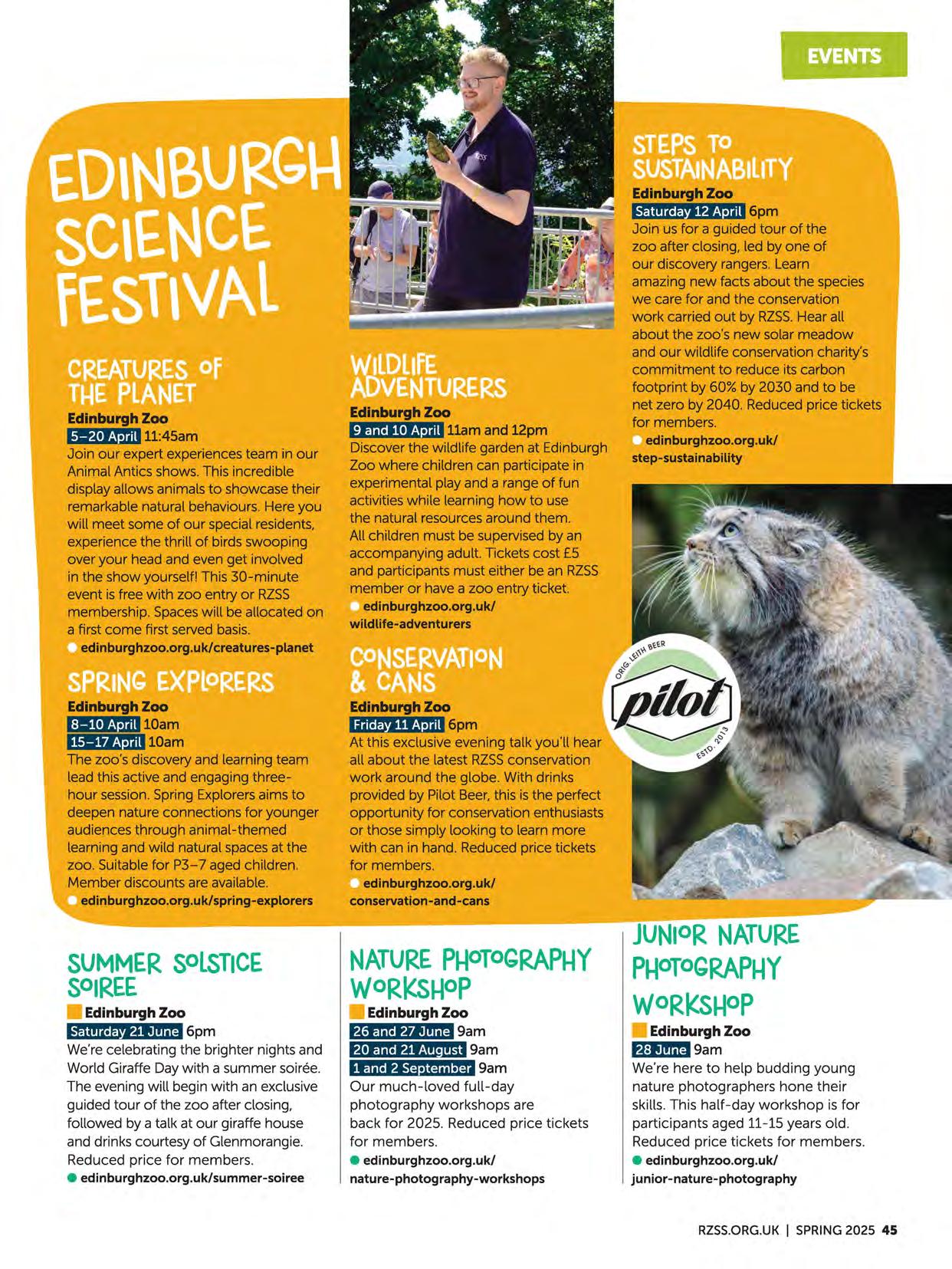
Edinburgh Zoo Saturda 12 April 6pm
Join us for a guided tour of the zoo after closing, led by one of our discovery rangers. Learn amazing new facts about the species we care for and the conservation work carried out by RZSS.Hear all about the zoo's new solar meadow and our wildlife conservation charity's commitment to reduce its carbon footprint by 60% by 2030 and to be net zero by 2040. Reduced price tickets for members.
edinburghzoo.org.uk/ step-sustainability
Edinburgh Zoo itfflMFJM 6pm
At this exclusive evening talk you'll hear all about the latest RZSSconservation work around the globe. With drinks provided by Pilot Beer, this is the perfect opportunity for conservation enthusiasts or those simply looking to learn more with can in hand. Reduced price tickets for members.
edinburghzoo.org.uk/ conservation-and-cans
W0 RKSl--l 0 P
Edinburgh Zoo
26 and 27 June 9am
20 and 21 Au ust 9am
1 and 2 September 9am
Our much-loved full-day photography workshops are back for 2025. Reduced price tickets for members.
• edinburghzoo.org.uk/ nature-photography-workshops
W0
Edinburgh Zoo t~=FUIU4 9am
We're here to help budding young nature photographers hone their skills. This half-day workshop is for participants aged 11-15 years old. Reduced price tickets for members.
• edinburghzoo.org.uk/ junior-nature-photography
In the gift shops at Edinburgh Zoo and Highland Wildlife Park, you'll find cuddly cousins of many of the real animals you meet on your visitsincluding some of our most unusual and fascinating species
1. Tortoise
£15
This eco tortoise soft toy (27cm) from Zappi is 100% recycled, and has a printed plush body with shell ridges and shaped toes. EG
2. Goat
£12.50
The 20cm goat by Keel is made from 100% recycled materials. It has felt features to rub and sweet embroidered eyes. EG
3. Snow monkey
£12.50
Monkey around with our 47cm hanging Japanese macaque, featuring the RZSSlogo.
4. Blue dart frog
£7.50
This eco blue dart frog (15cm) soft toy from Zappi has large feet and bouncy legs.
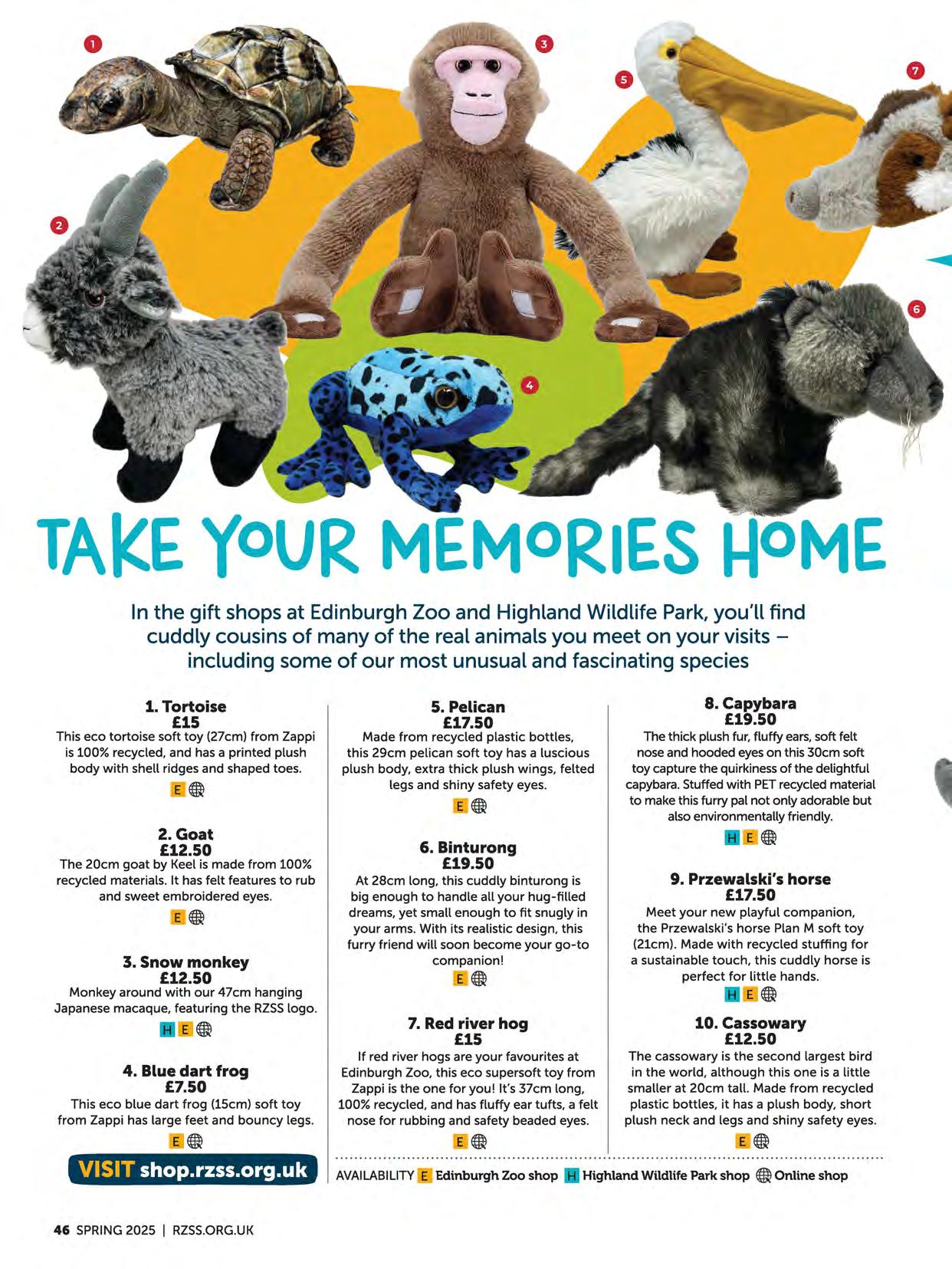
5.Pelican
£17.50
Made from recycled plastic bottles, this 29cm pelican soft toy has a luscious plush body, extra thick plush wings, felted legs and shiny safety eyes.
6. Binturong
£19.50
At 28cm long, this cuddly binturong is big enough to handle all your hug-filled dreams, yet small enough to fit snugly in your arms. With its realistic design, this furry friend will soon become your go-to companion!
7. Red river hog
£15
If red river hogs are your favourites at Edinburgh Zoo, this eco supersoft toy from Zappi is the one for you! It's 37cm long, 100% recycled, and has fluffy ear tufts, a felt nose for rubbing and safety beaded eyes.
8. Capybara
£19.50
The thick plush fur, fluffy ears, soft felt nose and hooded eyes on this 30cm soft toy capture the quirkiness of the delightful capybara. Stuffed with PETrecycled material to make this furry pal not only adorable but also environmentally friendly.
9. Przewalski's horse
£17.50
Meet your new playful companion, the Przewalski's horse Plan M soft toy (21cm). Made with recycled stuffing for a sustainable touch, this cuddly horse is perfect for little hands.
10. Cassowary
£12.50
The cassowary is the second largest bird in the world, although this one is a little smaller at 20cm tall. Made from recycled plastic bottles, it has a plush body, short plush neck and legs and shiny safety eyes.
11. Pallas's cat
£23.50
Get your paws on this 28cm high Pallas's cat. Featuring thick plush fur in varied textures, a fluffy mane, long whiskers and deep golden eyes. Stuffed with recycled materials, this cuddly soft toy captures the essence of the beautiful Pallas's cat.
£15
Waddle this way with our exclusive Edinburgh Zoo gentoo penguin embroidered with our famous Edinburgh Zoo logo. This perfectly cuddly pal (25cm) is made from 100% recycled materials and sports embroidered eyes and a fabulously expressive beak.

£15
Get cosy and cuddly with our hippo eco soft toy (30cm). Made from environmentally friendly materials, it is perfectly cuddly and a great way to remember your encounter with young Haggis, our adorable baby pygmy hippo.
Made exclusively for Edinburgh Zoo, the babygrow is £9.50 and available in 3-6 months, 6-12 months and 12-18 months sizes. The T-shirt is available in 1-2 years and 2-3 years sizes and costs £10. The bib is £7. All are available in white or pink.
Haggis the hippo tote bag
£3.50
100% cotton tote bag featuring a very cute illustration of the loveable Haggis the pygmy hippo.
Pin badges
£4.50
Get your hooves on these exclusive Haggis the hippo pin badges. They're 4cm x 2.5cm in size, with a safety stud back release.
An important part of any zoo gardener's job is understanding which plants make our animals feel at home. In the koala enclosure at Edinburgh Zoo, for example, native Australian plants enrich daily life for our three Queensland koalas, Kalari, Talara and Myaree. We have our own eucalyptus nursery, so we can harvest lots of soft, young leaves for our koalas to eat. But it's a planting style that could transform your own garden, too.
We recommend starting with a few taller plants such as acacia, tree ferns and eucalyptus, and underplanting with bushier shrubs such as bottlebrush, pittosporum and cordyline. Finally, add the annual Australian daisy, brachyscome, for a splash of colour at ground level. You'll have your own little patch of Aussie paradise in no time.
Nettles will soon be on the menu at Edinburgh Zoo's cafe, and they'll be grown right here, too. Until recently, the only creatures munching on our nettles have been Qabid, our greater one-homed rhinoceros who loves a large bag of fresh stinging nettles, and our local insects -butterfly caterpillars feed on nettles when they hatch and ladybirds feast on aphids sheltering among the leaves.
But now, our chef Scott has come up with some tasty nettle recipes. When cooked, nettle leaves lose the ability to 'sting', and the whole plant contains calcium, magnesium, iron and vitamins A and C. Soon, the basil and rocket
c urse will both contain ettle leaves; nettle juice will be n option in our new juice bar; and zoo staff will be tucking into nutritious nettle soup. So, next time you come across a patch of nettles in your garden, leave a few plants in place for the insects to enjoy and cut yourself some leaves to cook with.
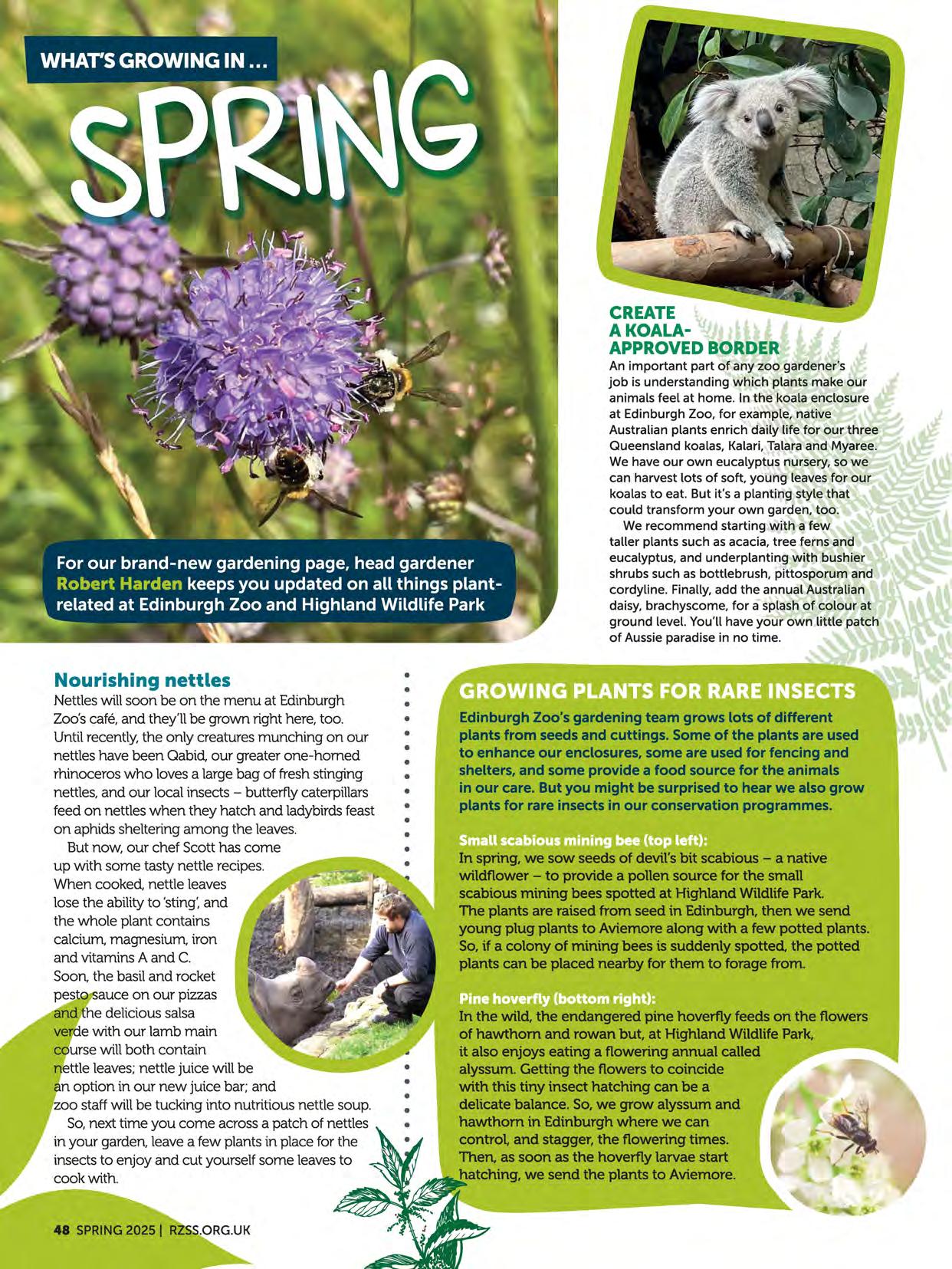
Edinburgh Zoo's gardening team grows lots of different plants from seeds and cuttings. Some of the plants are used to enhance our enclosures, some are used for fencing and shelters, and some provide a food source for the animals in our care. But you might be surprised to hear we also grow plants for rare insects in our conservation programmes
In spring, we sow seeds of devil's bit scabious -a native wildflower -to provide a pollen source for the small scabious mining bees spotted at Highland Wildlife Park. The plants are raised from seed in Edinburgh, then we send young plug plants to Aviemore along with a few potted plants. So, if a colony of mining bees is suddenly spotted, the potted plants can be placed nearby for them to forage from.
In the wild, the endangered pine hoverfly feeds on the flowers of hawthorn and rowan but, at Highland Wildlife Park, it also enjoys eating a flowering annual called alyssum. Getting the flowers to coincide with this tiny insect hatching can be a delicate balance. So, we grow alyssum and hawthorn in Edinburgh where we can control, and stagger, the flowering times. Then, as soon as the hoverfly larvae start hatching, we send the plants to Aviemore.
1. What is the name of Edinburgh Zoo's male Pallas'scat? (SJ
2. What is the name of Highland Wildlife Park's 28-year-old polar bear?(SJ
3. What species of animal is our social media star, Haggis? (5, SJ
4. Bindee, one of Edinburgh Zoo's new arrivals, is an Asiatic what? (4J
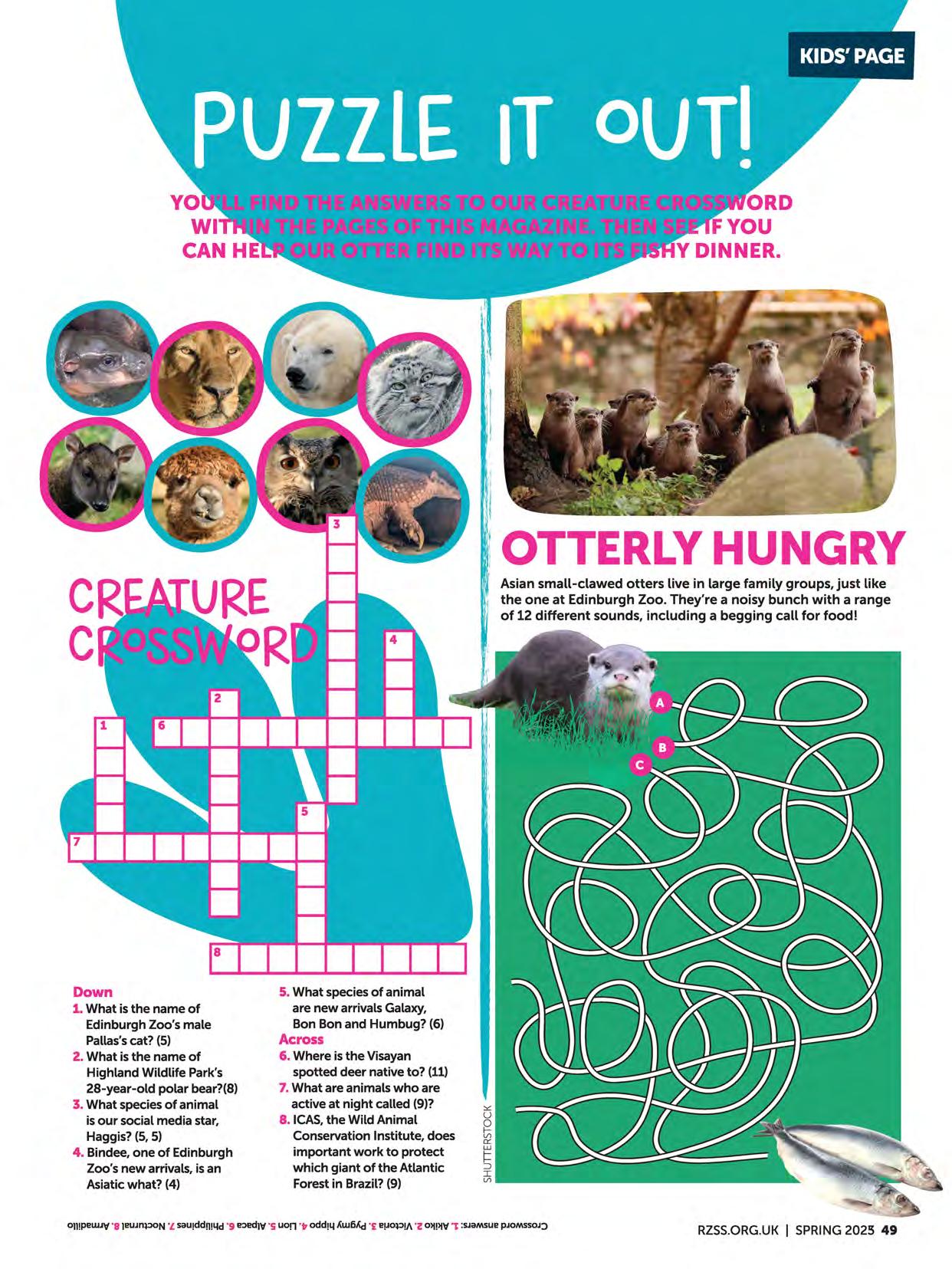
5. What species of animal are new arrivals Galaxy, Bon Bon and Humbug? (6) Across
6. Where is the Visayan spotted deer native to? (11)
7. What are animals who are active at night called (9)?
8. ICAS,the Wild Animal Conservation Institute, does important work to protect which giant of the Atlantic Forest in Brazil? (9J
Asian small-clawed otters live in large family groups, just like the one at Edinburgh Zoo. They're a noisy bunch with a range of 12 different sounds, including a begging call for food!
Above: The Nature Connections group at Highland Wildlife Park
Right: At home, Chloe enjoys animal-themed crafting hobbies
Fram first seeing the Amur tigers back in 2014, to celebrating Caramel the camel's 21st birthday last March, Chloe Gillings has had lots of unforgettable moments at Highland Wildlife Park. Many of those moments have come through Nature Connections, a community programme that creates an encouraging environment for people to explore the park and engage with its animals. Some of Chloe's favourite memories have been, "watching a wolf recall and seeing animals being fed, like polar bears".
She adds, "Nature Connections helps me feel close to nature and learn how we can all make a difference."
Chloe has also had the opportunity to meet Highland Wildlife Park's discovery and learning team who provide a wide range of activities for Nature Connections participants. She has particularly enjoyed the animal enrichment experiences.
"I loved helping Caramel the camel celebrate her 21st birthday by painting a box for her, and a large 21st key out of cardboard."
Chloe has also taken part in different seasonal activities such as the Bumblebee Conservation Trust's bee transect (a fixed monitoring route). For this she helped to track bumblebees in the park to record important conservation data, while interacting with and learning more about their buzzy brilliance. "I even had my nails painted with bees!"
11Nature Connections helps me feel close to nature and learn how we can all make a diHerence 11

Kirsty Strugnell, one of Highland Wildlife Park's learning and community officers, used to come to the park as Chloe's support worker from the Richmond Fellowship Scotland. After enjoying her time at the park and having seen how it benefited people such as Chloe, Kirsty applied to become a part of the park's discovery and learning team.
"It brings me joy to see the faces of --•••----the people we work with light up when we're exploring the park, meeting animals and doing activities such as enrichment. We always have a laugh and a lot of fun," says Kirsty.
Chloe visits the park often with her group including John, Ali, Alan and Mark.
Her favourite animal at Highland Wildlife Park is the Przewalski's horse and if she could describe Nature Connections in just one word, it would be "Smiles!"
Very sadly, Caramel the camel passed away on Wednesday 4 February 2025 after agerelated health issues. We are all missing her.
Step aboard Queen Elizabeth ll's former floating palace

Explore 5 decks from State Apartments to Crew's Quarters. Join the Cuddly Corgi Treasure Hunt!
